INTRODUCTION
Onions are one of the oldest vegetables in continuous cultivation dating back to at least 4,000 BCE. The ancient Egyptians are known to have cultivated this crop along the Nile River. There are no known wild ancestors, however, the center of origin is believed to be Afghanistan and the surrounding region. Onions are among the most widely adapted vegetable crops. They can be grown from the tropics to subarctic regions. This adaptation is primarily due to differing response to day length. Unlike most other species, day length influences bulbing in onions as opposed to flowering. Onions are grouped into three groups based on their response to hours of daylength. The short-day varieties bulb with daylengths of 10–13 hr, intermediate varieties bulb with day lengths of 13–14 hr and are found in the mid-temperate regions of this country. Finally, long-day onions are adapted to the most northern climes of the United States as well as Canada and bulb with daylengths greater than 14 hr.
Onions were first brought to this country by early European settlers. These onions were adapted to the temperate climate found throughout the Northeast where the first European settlements occurred. Varieties from warmer regions of the Mediterranean eventually made their way to the Southeastern United States. In particular, varieties from Spain and Italy would become important to the Vidalia onion industry. The first of these varieties came through Bermuda and were thus referred to as Bermuda onions.
Yellow Granex, the standard for Vidalia onions, has its origin from Early Grano. The variety Early Grano 502 resulted in the Texas Early Grano 951C, which became one of the parents for Yellow Granex hybrid. The other parent was YB986, which was selected from Excel, which in turn was derived from White Bermuda. The Granex name is a combination of Grano and Excel, the original parents.
The Vidalia onion industry began in 1931 when a grower by the name of Mose Coleman grew the first short-day onions in Toombs County. These mild onions were immediately popular with customers. At the beginning of the depression, these onions sold for $3.50 a 50-lb bag, a considerable amount of money at the time. Soon other growers became interested in these mild onions. The industry grew slowly and steadily for several decades.
Its growth was fueled by the fact that the city of Vidalia sat at the intersection of important roads prior to construction of the interstate highway system. In addition, the supermarket chain Piggly Wiggly maintained a distribution center in Vidalia and would buy the onions and distribute them through their stores. Slowly the industry began to gain a national reputation.
In order to help promote the onions further, onion festivals were started in both Vidalia and Glennville in the mid 1970’s. At this time, approximately 600 acres of onions were produced. Growth continued during the next decade. In 1986, the State of Georgia gave Vidalia onions official recognition and defined the geographic area where these onions could be grown. There had been some problems with onions being brought in from other areas and bagged as Vidalia onions. State recognition however did not give the industry the national protection it needed. Finally, in 1989, the industry was able to obtain Federal Market Order 955, which gave the industry national protection. The Vidalia Onion Committee was formed to oversee the Federal market order. Growers are required to register and give check-off funds to support the industry. Growers should check the Georgia Department of Agriculture website or call the Department for information about growing Vidalia onions. Growers are required to be within the defined growing regions, use specific approved varieties, and register with the state of Georgia. The Georgia Department of Agriculture website can be accessed at: http://www.agr. georgia.gov/vidalia-onion.aspx.
The collected money is used for national and international promotional campaigns as well as for research on onion production.
In 1989, the industry began to adopt controlled atmosphere (CA) storage. CA uses a low oxygen, high carbon dioxide refrigerated environment to store onions. This has allowed the industry to expand their marketing opportunities well into the fall months. The adoption of the Federal market order and CA storage has allowed this industry to grow to its current level of approximately 12,000 acres.
TRANSPLANT PRODUCTION AND DIRECT SEEDING
Short-day onions can be grown from both seed and transplants; however, the majority of onions are grown from transplants.
Transplant production begins in late summer with land preparation followed by seed sowing in September. Land for transplant production should not have been in onions or related Alliums for at least 3 years. This is not always possible with fixed center-pivot systems. Sites with a history of onion diseases and severe weed problems should be avoided, however.
Once a site has been selected, a soil test should be taken to determine the optimum level of fertility and soil pH. The University of Georgia has specific recommendations for plant bed onions. Therefore, when submitting a soil sample to the University of Georgia’s Soil Test Laboratory, make sure to indicate that they are for transplant or plant bed onion production. The site should be deep turned to bury any residue from the previous crop. Several different seeders are available for transplanting. These should be set to sow 60-70 seed per linear foot. As an example, using a Plant-It Jr. four-hopper transplanter, set the plates to No. 24. This should give the needed seeding rate for plant beds. Vacuum seeders are also a good choice and can accurately deliver seed in the amounts and to the depth required. Other seeders can be used as long as they are capable of sowing 60-70 seed per linear foot and can consistently plant the seed at the proper depth (1/4-1/2 in.).
The plant bed soil should have a pH range of 6.0-6.5 for optimum growth. Soils in Georgia are generally acidic, therefore, if your soil pH is low, applications of lime are recommended. Dolomitic lime is preferred over calcitic lime because it supplies both calcium and magnesium while adjusting the pH. Changing soil pH is a relatively slow process, therefore if low pH is suspected early soil testing and lime application is advantageous to ensure the soil pH is corrected in sufficient time for planting. Soil pH can take several months to change with lime applications.
Nitrogen recommendations on Coastal Plain soils range from 100 to 130 lb of nitrogen per acre. On Piedmont, Mountain, and Limestone Valley soils apply 90 to 120 lb per acre. Table 1 indicates the phosphorus and potassium recommendations based on soil residual phosphorus and potassium levels.
In addition, boron should be applied at 1 lb per acre. If zinc results are low, 5 lb per acre of zinc should be applied. Sulfur is critical for proper onion production. This is particularly true on the Coastal Plain soils of South Georgia that are very low in sulfur. Sulfur at a rate of 20-40 lb per acre will be required to produce quality onion transplants on these sandy loam soils.
A typical fertility program would consist of 300-400 lb per acre of 10-10-10 with 12% sulfur applied preplant. This would supply 30-40 lb of N-P-K along with 36-48 lb of S. This would be followed by additional applications of P and K according to soil test recommendations. Generally additional P will not be needed, while additional K can be supplied as potassium nitrate (13-0-44). The additional N can be supplied in one to two applications of calcium nitrate (15.5-0-0) applied at 4 and 6 weeks post seeding. It should be noted that any fertilizer that supplies the required nutrients as required by the soil test can be used to produce plant bed onions. More recent work indicates that high P applications at plant bed seeding have no effect. Phosphorus can have limited availability during periods of cool soil temperature, but plant bed seeding in September; soil temperatures are sufficiently high to avoid P deficiency; however, plant beds that have not been fertilized properly at seeding may require ‘pop-up’ fertilizer to overcome deficiencies during the cooler months of November and December.
It is critically important that seedbeds be irrigated regularly to develop a good plant stand. A tenth of an inch of water applied several times a day may be needed to ensure consistent soil moisture. See section on irrigation.
Plants are ready for harvest in about 8 to 10 weeks. Good quality transplants will be about the diameter of a pencil when ready. Transplants are pulled and bundled in groups of 50-80 plants and tied with a rubber band.
Approximately one half of the tops are cut from the transplants, usually with a machete. Harvested transplants are transported to the field in polyethylene net or burlap bags. Onion transplants can experience a ‘heat’ in these bags, which greatly reduces transplant survival. Care should be taken with transplants so they are not stored for excessively long periods of time in these bags, nor should they be left in the sun for too long. Planning is critical, harvest only enough plants that can be reasonably transplanted that day. Overnight storage in these bags should be avoided whenever possible, but if necessary they should be removed from the field to a cool dry location.
Alternatively, onions can be directly sown in the soil for production. This eliminates all of the fertilizer and other management requirements of transplant production. Timing and seedbed preparation are critical for successfully growing onions from direct seeding.
For direct seeding, onion seed should be sown on October 15 plus or minus 1 week. This is later than sowing for transplant production, but is required to avoid undue seed-stem formation (flowering) in the spring. The soil should be prepared so that it is free of clods and plant residue. The soil surface should be smooth with the proper amount of soil moisture. Soil that is too wet will clog the sowing equipment. Soil that is too dry may result in the seeder riding up on the soil and not sowing the seed at the proper depth. Seed should be sown with a precision seeder such as a vacuum planter set to sow seed at 4–6 in. in-row at a depth of 1⁄4–1⁄2 in. deep. The plant stand will be similar to transplanted onions with four rows on a slightly raised bed with 12–14 in. between the rows. Direct sowing can save a tremendous amount on costs and labor; however, care must be exercised to correctly sow the seed since you will only have one chance to get it right.
Table 1. Recommendations for phosphorus and potassium based on soil test analysis for plant bed onion production.
| N (lb/acre) | P (lb/acre) | K (lb/acre) | |||
| pH | Coastal Plain | Piedmont | Soil Test P & K | ||
| 6.0-6.5 | 100-130 | 90-120 | Low | 120 | 120 |
| Medium | 90 | 90 | |||
| High | 60 | 60 | |||
| Very High | 30 | 30 | |||
| Overload | 0 | 0 | |||
VARIETY SELECTION AND CHARACTERISTICS
As mentioned earlier, the type of onion grown in South Georgia is a short-day onion that bulbs during the short days of winter (> 11 hr daylength). Although limited research has been done in this area, it may be possible to grow intermediate-day onions in North Georgia; however, they would not be as mild as the south Georgia Vidalia onions.
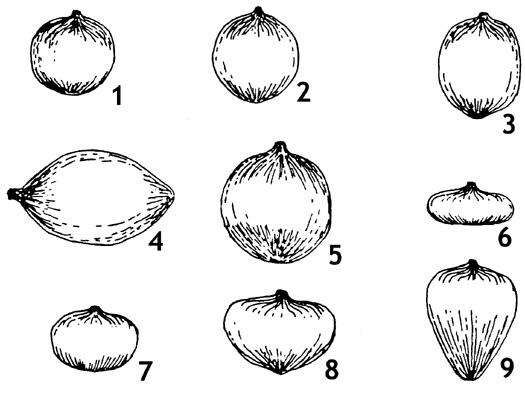
Figure 1. Bulb Shapes: 1. flattened globe; 2. globe; 3. high globe; 4. spindle; 5. Spanish; 6. flat; 7. thick flat; 8. Granex; 9. top (courtesy of Texas A&M University).
The Vidalia onion industry is controlled by a federal marketing order that is administered by the Vidalia Onion Committee and the Georgia Department of Agriculture. This market order defines what type of onions can be grown and be marketed as a Vidalia onion. A Vidalia onion must be a yellow Granex type. These onions should be slightly flattened, broader at the distal end (top) and tapering to the proximal end (bottom) (Figure 1). In addition, rules have given the Georgia Department of Agriculture the authority to determine acceptable varieties for the Vidalia industry. Under these rules, the University of Georgia has been mandated to test all onion varieties for 3 years before making recommendations to the Georgia Commissioner of Agriculture. Varieties that the Georgia Department of Agriculture have recommended to be grown as Vidalia onions are listed in Table 2.
Table 2. List of approved Vidalia onion varieties (2014).
| Variety | Source | Season |
| Allison | D. Palmer Seed | Mid |
| Caramelo | Nunhems USA Inc. | Mid |
| Century | Seminis Seed | Mid |
| DP Sweet 1407 | D. Palmer Seed | Mid |
| Georgia Boy | D. Palmer Seed | Mid |
| Goldeneye | Seminis Seed | Mid |
| Gianex Yellow PRR | Seminis Seed | Mid |
| Honeybee | Shamrock | Early |
| Miss Megan | D. Palmer Seed | Mid |
| Me. Buck | D. Palmer Seed | Mid |
| Nirvana | Nunhems USA Inc. | Mid |
| Nunhems NUN1002 | Nunhems USA Inc. | Mid |
| Nunhems NUN1003 aka Vidora | Nunhems USA Inc. | Mid |
| Nunhems NUN1006 aka Plethora | Nunhems USA Inc. | Mid |
| Pirate | Bejo Seed | Mid |
| Ringo | Sakata Seed | Mid |
| Spell Sweet | D. Palmer Seed | Mid |
| Savannah Sweet | Seminis Seed | Mid |
| Candy Ann | Solar Seed | Early |
| Candy Kim | Solar Seed | Early |
| Sweet Agent | Seminis Seed | Early |
| Sweet Caroline | Nunhems USA Inc. | Mid |
| Sweet Harvest | Sakata Seed | Mid |
| Sweet Jasper | Sakata Seed | Mid |
| Sweet UNO | Enza Zaden | Mid |
| Sweet Vidalia | Nunhems USA Inc. | Mid |
| WI-129 | Wannamaker Seed | Early |
Onion varieties grown in Southeast Georgia fall into three broad maturity categories; early, mid-season, or late. There can; however, be considerable overlap in these categories and not all varieties will perform the same as to their maturity from one year to the next.
Along with maturity, varieties will perform differently on a wide range of quality attributes, as well as yield. Varieties can differ for pungency, sugar content, disease resistance, seed stem formation, double centers, bulb shape, and bulb size. Growers should consider all of these characteristics when making decisions on variety selection. Growers wishing to try new varieties should consult University of Georgia variety trial results. Trial results should be examined over several years to get a true picture of a variety’s potential. Even after evaluating trial data, growers considering new varieties should grow them on limited acreage to get a feel for their performance potential under their growing conditions. In addition, growers wishing to grow Vidalia onions should check with the Georgia Department of Agriculture for the current allowed varieties.
SOILS AND FERTILIZER MANAGEMENT
Onions grow best on fertile, well-drained soils. Tifton series 1 and 2 soils are found in the Vidalia onion area and are well suited for onion production. However, most sandy loam, loamy sand or sandy soils will be advantageous to sweet onion production. These soils are inherently low in sulfur, which allows greater flexibility in sulfur management to produce sweet onions. Avoid soils with heavy clay content and coarse sandy soils. Clay soils tend to have a higher sulfur content, which can lead to pungent onions. Exceedingly sandy soils are more difficult to manage because they require more fertilizer and water.
Fertilizer and lime requirements should always be based on a recent, properly obtained soil sample. Check with your local county extension office or crop consultant regarding proper procedures for soil sampling and interpretation of results. Obtain the soil sample a few months prior to crop establishment in order to determine lime requirements and make necessary lime applications in a timely manner. If soil test results show a pH below 6.0, apply and disk in dolomitic lime 2 to 3 months before land preparation to bring the pH to the optimum range of 6.2 to 6.5. It is essential to apply sufficient lime to keep the soil pH above 6.0. Low pH can cause nutrient deficiencies during the growing season. Also, the high rates of fertilizer used in producing onions cause the pH to drop during the growing season. If the pH is not corrected at the beginning of the onion season, nutrient deficiencies could occur during the year and reduce yield. Calcium and phosphorous deficiencies can often be linked to low pH, even though soil tests indicate adequate levels. But phosphorus deficiencies due to low pH can be difficult to correct during the growing season.
Onions require more fertilizer than are used in most vegetable crops because fertilization of both plantbeds and dry bulb onions must be considered. They respond well to additional fertilizer applied 40 to 60 days after seeding or transplanting. The method of fertilizer application is very important in obtaining maximum yield with multiple applications insuring good yields. This will increase the amount of fertilizer utilized by the plant and lessen the amount lost from leaching. More recent research; however, indicates that good results can be obtained with as few as three fertilizer applications. Preplant fertilizer will vary with the natural fertility and cropping history. Proper application methods and function of various nutrients are outlined below. Table 3 shows a suggested fertilizer program for a soil testing medium in P and K.
Nitrogen (N), especially in nitrate (NO3) form, is extremely leachable. If too little nitrogen is available, onions can be severely stunted. High nitrogen rates are believed to produce succulent plants that are more susceptible to chilling or freezing injury, disease, and to production of flower stalks. Onions, heavily fertilized with nitrogen, are believed to not store well. Finally, excess nitrogen late in the growing season is believed to delay maturity and causes double centers. Make the final nitrogen application at least 4 weeks prior to harvest. Rates of nitrogen will vary depending on soil type, rainfall, irrigation, plant populations and method and timing of applications. For dry bulb production from transplanting or direct seeded onions should require between 125-150 lb/acre nitrogen. It is usually best to incorporate 25% to 30% of the recommended nitrogen prior to planting and apply the remainder in two or three split applications.
Phosphorus (P) is essential for rapid root development. It is found in adequate levels in most soils but is not readily available at low soil temperatures. Because of these factors, under most conditions all of the P should be applied preplant and incorporated before transplanting. This amount should be counted as part of the total seasonal fertilizer application. Table 4 shows the recommended phosphorous to be applied based on various soil test levels.
Potassium (K), is an important factor in plant water relations, cell-wall formation and energy reactions in the plant. Potassium is also subject to leaching from heavy rainfall or irrigation. Therefore, it is best to split K applications by incorporating 30% to 50% of the recommended K before planting and splitting the remainder in one to two sidedress applications. A low K level makes plants more susceptible to cold injury. Table 4 lists recommended K applications based on soil test results.
Sulfur (S) is an essential element for plant growth. Early applications of sulfur are advisable in both direct-seeded and transplanted onions. To minimize pungency, fertilizers that contain S should not be applied after the end of January. Research conducted in Georgia on S and onion pungency has shown that pungency (pyruvate analysis) of mature onions increases with high rates of S or whenever S applications are made after late January. Therefore, S should not be applied to onions after late January unless the onions exhibit S deficiency. Do not completely eliminate S from the fertility program. Apply 40 to 60 lb of elemental S with half incorporated at transplanting or seeding and half applied at the first sidedress application. Do not apply S in rates higher than 40-60 lb/acre.
Boron (B) is required by direct-seeded or transplanted onions in the field. If the soil test shows B levels are low, apply 1 lb of B per acre and incorporate prior to transplanting or seeding. Do not exceed the recommended amount since boron can be toxic to onions.
Zinc (Zn) levels determined to be low by soil testing can be corrected by applying 5 lb of Zn per acre. Excessive amounts of Zn can be toxic, so apply only if needed. Zinc is usually added in the preplant fertilizer.
Magnesium (Mg) levels in the soil must be adequate for good onion growth. If dolomitic limestone is used in the liming program it will usually supply some of the required Mg. However, if soil pH is adequate and the soil-test Mg level is low, apply 25 lb of Mg per acre in the preplant fertilizer.
Slow release fertilizers have been introduced to the Vidalia growing region. These fertilizers have performed well and can be considered in a fertility program. These fertilizers; however, have not proven satisfactory for single fertilizer application.
Table 3. Sample fertilizer recommendations for transplanted onions with a plant population of 60,000 to 80,000 plants per acre. Make adjustments for soil test levels other than medium P and medium K.
| Timing | Amount (lb/acre) | Type | Method | N | P2O5 | K2O | S |
| Preplant | 400 | !0-10-10 with 12% S | Broadcast & incorporate | 40 | 40 | 40 | 48 |
| January |
85 250 200 |
0-0-60 0-20-0 15.5-0-0 |
Broadcast |
0 0 31 |
0 50 0 |
50 0 0 |
|
| February | 520 | 15.5-0.0 | Broadcast | 81 | 0 | 0 | |
| Total | 152 | 90 | 90 | 48 |
A complete fertilizer with minor elements will provide most of the other required nutrients. Micronutrients can become toxic, if excessively applied so apply them only when needed and in precise amounts. Routine visual inspection of onion fields to watch for nutrient deficiencies is always important. However, during periods of high rainfall or frequent irrigation, be particularly aware of the potential for nutrient deficiencies to occur.
Deficiencies of major nutrients cannot be feasibly corrected through foliar nutrient applications. Therefore, it is important to properly manage soil fertility to maintain optimum growth and development. Some deficiencies of minor elements can be remedially corrected through foliar applications. However, it is always best to supply adequate amounts of these nutrients through your basic soil fertility program. Plants utilize nutrients more efficiently when the nutrients are taken up from the soil. Also, by the time you visually see a deficiency symptoms, you have probably already lost some potential yield.
Table 4. Recommended potassium and phosphorous applications based on soil test ratings of each nutrient.*
| Potassium | |||||
| Phosphorous Rating | Low | Medium | High | Very High | Overload |
| (Pounds N-P2O5-K2O per acre) | |||||
| Low | -120-120 | -120-90 | -120-60 | -120-30 | -120-0 |
| Medium | -90-120 | -90-90 | -90-60 | -90-30 | -90-0 |
| High | -60-120 | -60-90 | -60-60 | -60-30 | -60-0 |
| Very High | -30-120 | -30-90 | -30-60 | -30-30 | -30-0 |
| Overload | -0-120 | -0-90 | -0-60 | -0-30 | -0-0 |
*Nitrogen recommendations: Coastal Plain Soils: 130-150 lb/acre N. Piedmont, Mountain and Limestone Valley Soils: 110-130 lb/acre N.
Plant Tissue Analysis
Plant tissue analysis is an excellent tool to evaluate crop nutrient status. Periodic tissue analysis can be used to determine if fertility levels are adequate or if supplemental fertilizer applications are required. Tissue analysis can often be used to detect nutrient deficiencies before they are visible.
Plant tissue analysis is accomplished by sampling the most recently mature leaves of the plant. A sample of 20-30 leaves should be taken from the field area(s) in question. Check with your local county extension office or crop consultant on proper tissue analysis techniques. The University of Georgia through its Plant, Soil, and Water Testing Laboratory can analyze your samples. Table 5 shows critical ranges for nutrient concentrations in onion tissue for the crop stage just prior to bulb initiation.
Table 5. Plant tissue analysis critical values for dry bulb onions.
| Nutrient | N | P | K | Ca | Mg | S | Fe | Mn | Zn | B | Cu | Mo |
| Units | Percent | Parts per million | ||||||||||
| Status | ||||||||||||
| Deficient | <2.0 | 0.20 | 1.5 | 0.6 | 0.15 | 0.2 | 50 | 10 | 15 | 10 | 5 | - |
| Adequate | 2.0-3.0 | 0.20-0.50 | 1.5-30 | 0.6-0.8 | 0.15-0.30 | 0.2-0.6 | 50-100 | 10-20 | 15-20 | 10-25 | 5-10 | - |
| High | >3.0 | 0.50 | 3.0 | 0.8 | 0.30 | 0.6 | 100 | 20 | 20 | 25 | 10 | - |
| Toxic | - | - | - | - | - | - | - | - | - | - | 100 | - |
Adapted from Vegetable Production Guide for Florida. Pub. No. SP 170. Univ. of Florida Cooperative Extension Service. 1999.
CULTURAL PRACTICES
Transplants (see Transplant Production) are generally set in November to December. They can, however, be successfully set in January. Plants set in February will generally be smaller at maturity. Consequently, they will have a smaller percent of jumbos. Early varieties should be planted prior to the end of December. If planted late, they will have lower yields and smaller bulbs because they are strongly daylength sensitive and will ‘go down’ (tops break over at the neck) or reach maturity earlier than other varieties.
Transplants are field set on slightly raised beds approximately 4 ft wide. Beds are 6 ft center to center. These beds or panels, as they are sometimes called, will have four rows of onions spaced 12–14 in. apart and a spacing of 4.5 to 6 in. within the row (Figure 2). The spacing is determined by peg spacing on a pegger used to place holes in the bed surface 1 to 2 in. deep (Figure 3). Transplants are hand set in each hole.
Onions grow slowly during the cool short days of winter. Because of this, fertilizer, pesticide, and irrigation practices must minimize disease while maintaining optimum growing conditions.

Figure 2. Typical onion field.

Figure 3. Pegger
Harvest maturity is reached when 20-50% of the onion tops are down. In most seasons, onion neck tissue will break down when the plant is mature. Although this is a good rule-of-thumb for determining when onions mature, the tops may not go down as readily in some years or for some varieties. In addition, early varieties are very day length sensitive and usually go down early and uniformly. These early varieties should be harvested when 100% of the tops go down. They can be allowed to stay in the field for a week after tops down and will continue to enlarge. This will increase yield as the bulbs continue to increase in size. Knowing the variety and carefully inspecting the crop is the best method to determine maturity. Whether the tops go down or not, the neck tissue will become soft, pliable, and weak at maturity. Onions harvested too early may be soft and not dry down sufficiently during curing. In addition, they may begin to grow because they are not completely dormant. If the onions are harvested too late, there may be an increase in postharvest diseases and sunscald on the shoulder of the bulb. Although F1 hybrids will have a narrow window of maturity, they will not all mature at once. Generally, a field of onions will be harvested before all the bulbs have their tops down.
Onions are prone to physiological disorders that growers should try to minimize. One such disorder is splits or doubles. This condition is caused by cultural and environmental factors as well as being influenced by genetics. Over-fertilization, uneven watering, and temperature fluctuations (particularly below 20 °F) are all believed to have an influence on double formation. Some varieties are more prone to production of doubles than others. Varieties prone to doubling should be seeded a week or so later on the plant beds as well as transplanted a bit later to minimize this disorder.
Onions are biennials forming bulbs the first year, which will act as a food source the following year when the plant flowers. The process of flowering in onions is called bolting. A seedstalk or scape will form very quickly and appear to bolt up. These flower stalks or seedstems can form in the first year if appropriate environmental conditions occur and plant size are favorable. Cool temperatures during the latter part of the growing season (March and April), when plants are relatively large, can result in a high percentage of seedstems. There also appears to be a variety component to seedstem formation.
Onions can generally withstand light to heavy frosts, but hard freezes can result in onion damage. Freeze injury may be readily detectable as translucent or water soaked outer scales of the bulbs. A day or two after the freeze event, onions should be cut transversely to see if translucent scales are present. In some cases, freeze damage may not be readily detectable for several days. In these cases, the growing point may have been affected and subsequent growth will be abnormal, increasing the incidence of doubles. Apparently, the growing point is damaged to the extent that two growing points develop. Under severe freeze conditions the plant may be killed. Control of freeze and frost injury is usually done by cultivating the fields, if such an event is anticipated. Cultivating fields results in a layer of moist soil at the surface which acts as insulation. This holds the day’s heat in the soil around the bulb and root. The downside to cultivating may increase the incidence of disease caused by throwing up contaminated soil on tender onion tissue.
Onions may develop disorders that are not associated with insect, disease, or nutrient problems. Greening is one such occurrence. This occurs when the bulb is exposed to sunlight for an extended period of time. Early fertilizer application is needed to develop a strong healthy top, which shade the bulb during development.
Sunscald will occur at the shoulder of all onions that are exposed to sunlight for an extended period of time. Bulb sunscalding can occur when maturity is reached and harvest is delayed. Harvest should occur as soon as possible after the crop has matured. Scales several layers deep will dry and turn brown. Under severe conditions the internal tissue may actually cook or, become soft and translucent.
Translucent scale is a physiological disorder similar in appearance to freeze injury. The big difference is, freeze injury will always affect the outer scales whereas translucent scale may first appear on scales several layers deep in the bulb. Translucent scale is a postharvest phenomenon caused by high CO2 in storage facilities. This is most likely to occur in refrigerated storage without adequate ventilation. CO2 levels above 8% will increase the chance of translucent scale. Growers and packers should carefully monitor storage facilities to prevent this.
Physical damage of onions may appear that may be confused with botrytis leaf blight (see disease section). This damage is usually caused by wind-blown sand or hail. Strong winds can cause flecking of leaves particularly in fields with dry sandy soils. Hail damage will usually be more severe with large (0.125–0.25 in. in diameter) white or yellow lesions on the leaves. The shoulders of the exposed bulbs will often have a dimpled feel. In severe cases, the crop can be defoliated and destroyed.
Occasionally plants may exhibit a striped appearance. If this is widespread in a field, S deficiency is the probable cause (see fertility section). If it appears on an isolated plant, it is probably a chimera. Chimeras result when a mutation occurs in the meristematic tissue (growing point) resulting in a striped plant. This should not be a concern.
IRRIGATING SWEET ONIONS IN GEORGIA
Because of the importance of water management in onions, all commercially grown onions in Georgia are irrigated. Research and extension trials in Georgia have indicated that properly irrigated onions will yield 25% to 50% more than dry land onions. Irrigated fields typically yield a higher percentage of jumbo bulbs, which generally bring a higher price on the market. Irrigated onions are sweeter and less pungent than dryland onions, which is especially important for Vidalia onions.
Irrigation System Options
Almost all onions in Georgia are sprinkler-irrigated. The two most commonly used systems are center pivots and traveling guns.
Center pivot systems are generally one of the lowest cost systems per acre to install and require very little labor to operate. If properly maintained, they apply water very uniformly, and because of the low pressure required to operate them, they are generally very energy efficient. They are not well adapted to small irregular shaped fields, and unless the system is towable, it is restricted to use in only one field. If a farmer has a limited amount of irrigated land, this characteristic can be detrimental to desirable crop rotations.
Traveling guns are mobile systems that can be moved from field to field or farm to farm. They can be used on almost any shaped field. They do require high water pressure to operate and consequently require more fuel per acre-inch of water than other options. Traveling guns also require a considerable amount of labor to operate. These systems tend to increase soil compaction and are harsh on young plants.
Other irrigation systems can be used as long as they can supply the need water evenly over the entire field.
Irrigation Scheduling
Water use of onions varies considerably throughout the growing period and varies with weather conditions. The peak water demand for onions can be as high as 1.5 to 2.0 in. per week. Peak use generally occurs during the latter stages of bulb enlargement especially during periods of warm weather. However, there are other stages when supplemental water may be needed.
Transplanted onions should be watered very soon after setting. About 1/2 in. applied at this time will help establish good contact between the soil and roots and assure a good stand.
During the next 2 or 3 months the plants will be small and have a relatively shallow root system. The fall months also tend to be some of the driest months in Georgia. During this period, irrigation should be applied whenever the soil becomes dry in the top 6 in. Irrigation amounts should be limited to about 1/2 in. per application during this stage. Irrigation applications are typically infrequent during this period, since the plants are small and water demand is relatively low.
When the bulbs begin to enlarge water demand will gradually increase as will the need to irrigate when the weather turns dry. Rooting depths at this stage are typically 12 in. or less. Because of the shallow rooting depth, irrigation applications should not exceed 1.0 in. Typical applications should range between 0.6 and 1.0 in., for loamy soils and for sandy soils, respectively. During dry weather, irrigate two or three times per week, especially when the weather is warm. Of course, when temperatures are cool, irrigations may be less frequent.
Unlike most other crops, onions do not generally wilt when they experience moisture stress. Since moisture stress is difficult to detect by visual inspection, it is very helpful to monitor soil moisture. This can be done by installing tensiometers or electric resistance blocks or any other moisture sensor in the soil. Install soil moisture sensors at two depths, one near the middle of the root zone and one near the bottom. Common practice is to install one at 4 to 6 in. and one at 10 to 12 in. The ideal range for soil moisture is between (soil tension) 5 and 20 centibars for most coastal plain soils. Readings of less than 5 indicates saturated conditions and above 20 indicates the soil is becoming dry. If you use a center pivot or traveling gun, you should start early enough so that the last part of the field to get watered does not get too dry before the system gets there.
In general, if the system requires 3 days to water the entire field, then you should install at least three soil moisture stations, evenly spaced around the field. Each station will consist of two sensors, one shallow and one deep. You should monitor the readings on the soil moisture sensors at least three times per week when the weather is dry.
CHEMICAL APPLICATION
Two types of sprayers, boom and air-assisted, are used for applying insecticides, fungicides, herbicides, and foliar fertilizers. Air-assisted sprayers (Figure 4) utilize a conventional hydraulic nozzle, plus air to force the spray into the plant foliage. Boom sprayers (Figure 5) get their name from the arrangement of the conduit that carries the spray liquid to the nozzles. Booms or long arms on the sprayer extend across a given width to cover a swath as the sprayer passes over the field.
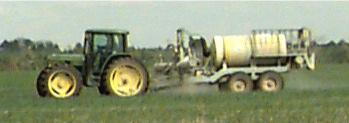
Figure 4. Air assisted sprayer.
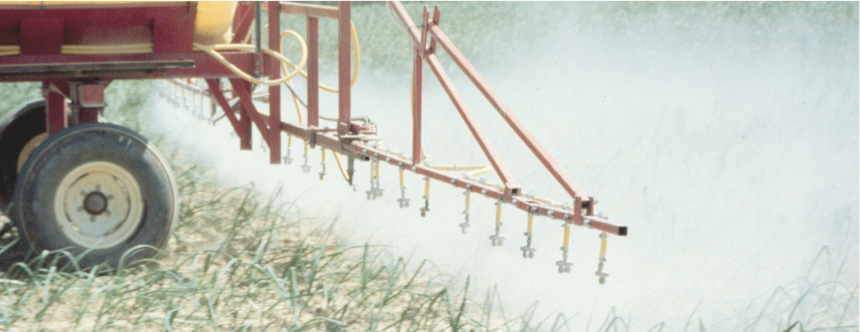
Figure 5. Boom sprayer.
Pumps
Three factors to consider in selecting the proper pump for a sprayer are capacity, pressure, and resistance to corrosion and wear. The pump should be of proper capacity or size to supply the boom output and to provide for agitation 5 to 7 gallons per minute (gpm) per 100-gallon tank capacity. Boom output will vary depending upon the number and size of nozzles. Also, 20% to 30% should be allowed for pump wear when determining pump capacity. Pump capacities are given in gallons per minute. The pump must produce the desired operating pressure for the spraying job to be done. Pressures are indicated as pounds per square inch (psi). The pump must be able to withstand the chemical spray materials without excessive corrosion or wear. Use care in selecting a pump if wettable powders are to be used as these materials will increase pump wear.
Before selecting a pump, consider factors such as cost, service, operating speeds, flow rate, pressure and durability. For spraying vegetable crops, a diaphragm pump is preferred because of service ability and pressures required.
Nozzles
Nozzle selection is one of the most important decisions to be made related to pesticide applications. The type of nozzle determines not only the amount of spray applied, but also the uniformity of application, the coverage obtained on the sprayed surfaces, and the amount of drift that can occur. Each nozzle type has specific characteristics and capabilities and is designed for use under certain application conditions. The types which are commonly used for ground application of agricultural chemicals for onions are the fan and cone nozzles.
Herbicides
The type of nozzle used for applying herbicides is one that develops a large droplet and has no drift. The nozzles used for broadcast applications include the extended range flat fan, drift reduction flat fan, turbo flat fan, flooding fan, turbo flooding fan, turbo drop flat fan, and wide angle cone nozzles. Operating pressures should be 20 to 30 psi for all except drift reduction and turbo drop flat fans, flooding and wide angle cones. Spray pressure more than 40 psi will create significant drift with flat fan nozzles. Drift reduction and turbo drop nozzles should be operates at 40 psi. Flooding fan and wide angle cone nozzles should be operated at 15 to 18 psi. These nozzles will achieve uniform application of the chemical if they are uniformly spaced along the boom. Flat fan nozzles should overlap 50% to 60%.
Insecticides and Fungicides
Hollow cone nozzles are used primarily for plant foliage penetration for effective insect and disease control, when drift is not a major concern. At pressures of 60 to 200 psi, these nozzles produce small droplets that penetrate plant canopies and cover the underside of the leaves more effectively than any other nozzle type. The hollow cone nozzles produce a cone shaped pattern with the spray concentrated in a ring around the outer edge of the pattern. Even fan and hollow cone nozzles can be used for banding insecticide or fungicides over the row.
Nozzle Material
Various types of nozzle bodies and caps, including color-coded versions, and multiple nozzle bodies are available. Nozzle tips are interchangeable and are available in a wide variety of materials, including hardened stainless steel, stainless steel, brass, ceramic, and various types of plastic. Hardened stainless steel and ceramic are the most wear-resistant materials. Stainless steel tips, even when used with corrosive or abrasive materials, have excellent wear resistance. Plastic tips are resistant to corrosion and abrasion and are proving to be very economical for applying pesticides. Brass tips have been common, but wear rapidly when used to apply abrasive materials such as wettable powders. Brass tips are economical for limited use, but other types should be considered for more extensive use.
Water Rates (GPA)
The grower who plans to use spray materials at the low water rate should follow all recommendations carefully. Use product label recommendations on water rates to achieve optimal performance. Plant size and condition influence the water rate applied per acre. Examination of the crop behind the sprayer before the spray dries will give a good indication of coverage.
Other irrigation systems can be used as long as they can supply the need water evenly over the entire field.
Agitation
Most materials applied by a sprayer are in a mixture or suspension. Uniform application requires a homogeneous solution provided by proper agitation (mixing). The agitation may be produced by jet agitators, volume boosters (sometimes referred to as hydraulic agitators), and mechanical agitators. These can be purchased separately and installed on sprayer tanks. Continuous agitation is needed when applying pesticides that tend to settle out, even when moving from field to field or when stopping for a few minutes.
Nozzle Arrangements
When applying insecticides and fungicides, use a broadcast boom arrangement. Place nozzles on 10 to 12 in. centers for complete coverage of the plant.
Calibration
The procedure below is based on spraying 1/128 of an acre per nozzle or row spacing and collecting the spray that would be released during the time it takes to spray the area. Because there are 128 oz of liquid in 1 gallon, this convenient relationship results in ounces of liquid collected being directly equal to the application rate in gallons per acre.
Calibrate with clean water when applying toxic pesticides mixed with large volumes of water. Check uniformity of nozzle output across the boom. Collect from each for a known time period. Each nozzle should be within 10% of the average output. Replace with new nozzles if necessary. When applying materials that are appreciably different from water in weight or flow characteristics, such as fertilizer solutions, etc., calibrate with the material to be applied. Exercise extreme care and use protective equipment when active ingredient is involved.
Table 6. Distance to measure to spray 1/128 acre. One ounce discharged equals 1 gallon per acre.
| Nozzle Spacing (inches) | Distance (feet) | Nozzle Spacing (inches) | Distance (feet) |
| 6 | 681 | 20 | 204 |
| 8 | 520 | 22 | 186 |
| 10 | 408 | 24 | 170 |
| 12 | 340 | 30 | 136 |
| 14 | 292 | 36 | 113 |
| 16 | 255 | 38 | 107 |
| 18 | 227 | 40 | 102 |
To determine a calibration distance for an unlisted spacing, divide 340 by the spacing expressed in feet. Example: Calibration distance for a 13-in. band = 340 ÷ (13 ÷ 12) = 313 ft.
- From Table 6, determine the distance to drive in the field (two or more runs are suggested). For broadcast spraying measure the distance between nozzles. For band spraying, use band width. For over the row or directed use row spacing.
- Measure the time (seconds) to drive the required distance; with all equipment attached and operating. Maintain this throttle setting!
- With sprayer sitting still and operating at same throttle setting or engine RPM as used in Step 2, adjust pressure to the desired setting. Machine must be operated at same pressure used for calibration.
- For broadcast application, collect spray from one nozzle or outlet for the number of seconds required to travel the calibration distance.
- For band application, collect spray from all nozzles or outlets used on one band width for the number of seconds required to travel the calibration distance.
- For row application, collect spray from all outlets (nozzles, etc.) used for one row for the number of seconds required to travel the calibration distance.
- Measure the amount of liquid collected in fluid ounces. The number of ounces collected is the gallons per acre rate on the coverage basis indicated. For example, if you collect 18 oz, the sprayer will apply 18 gallons per acre. Adjust applicator speed, pressure, nozzle size, etc. to obtain recommended rate. If speed is adjusted, start at Step 2 and recalibrate. If pressure or nozzles are changed, start at Step 3 and recalibrate.
DISEASES OF VIDALIA ONIONS
Onion diseases can cause severe losses by reducing yield and quality of marketable onions. These onion diseases can occur in seedbeds, production fields and in storage. Disease management requires a systems approach that involves practices such as rotation, sanitation, optimum fertilization, preventive fungicide/bactericide applications, harvest timing, and proper harvesting, handling, and storage. If one or more of these practices are omitted, disease management is significantly compromised.
Fungal Diseases Affecting Roots and Underground Plant Parts
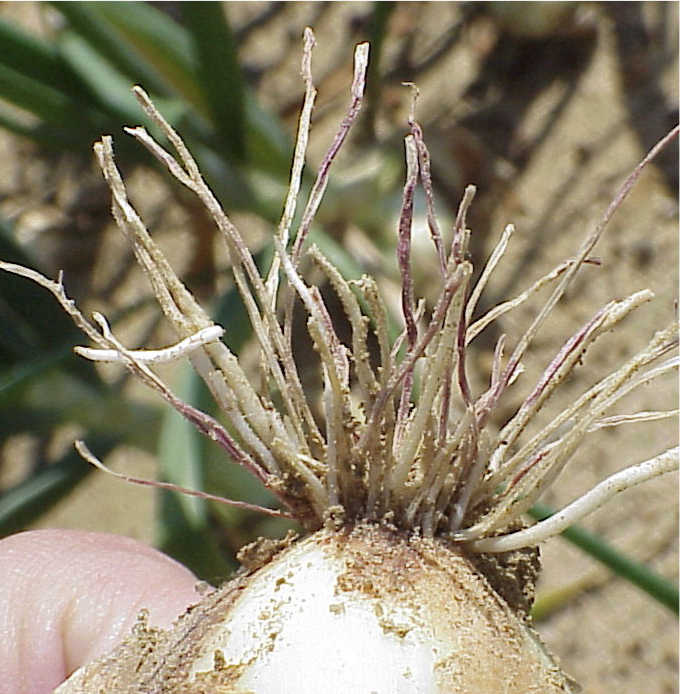
Figure 6. pink colored onion roots of onions infected with pink root (Phoma terrestris).
Pink root
Pink root, caused by the fungus Phoma terrestris, is the most common and damaging root disease of onions in Georgia. This disease is greatly enhanced by stresses imposed on plants such as heat, cold, drought, flooding, and nutrient toxicities/deficiencies. The fungus reproduces and survives indefinitely in soil; therefore, continuous production of onions in the same field results in increased losses to pink root.
Symptoms: The name of this disease is its most descriptive symptom. Roots infected by the pink root fungus turn pink or sometimes appear purplish (Figure 6). Infected roots eventually turn brown and deteriorate. Onions in both seedbeds and production fields can become infected. Early infected plants may die or may not produce usable bulbs. Later infected plants are stunted, producing small, unmarketable bulbs.
Management Options: Utilizing a long rotation to non-related crops (3–7 years) can work as a management strategy for reducing losses to pink root; however, this may not always be possible. Also, correct soil tilth, fertility and water management will reduce stresses which enhance disease development. The optimum temperature for growth and infection by pink root is 79 °F, therefore delaying planting until soil temperatures average 75 °F or below will allow for roots to grow and develop prior to temperatures that enhance infection. Harvesting onions prior to soil temperatures reaching 79 °F will allow onions to escape further pink root infection. Fumigation with metam sodium, chloropicrin and 1,3-D dichloropropene (Telone) have been shown to increase yields when onions have been planted to fields heavily infested with pink root. Onion varieties resistant to pink root that also have horticulturally acceptable qualities should also be considered.
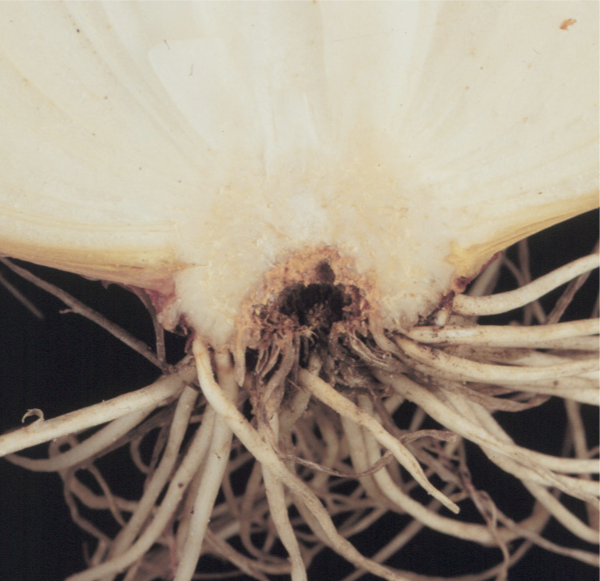
Figure 7. Onion basal plate infected with Fusarium basal rot.
Fusarium Basal Rot
Fusarium basal rot is caused by the fungus Fusarium oxysporum f. sp. cepae. This disease occurs sporadically in the Vidalia area. Losses to this disease can occur in the field and later when onions are in storage. Like pink root, Fusarium basal rot can build up in soils where onions are grown year after year.
Symptoms: Symptoms may be observed in the field as yellowing leaf tips which later become necrotic. This yellowing and/or necrosis may progress towards the base of infected plants. Sometimes leaves of infected plants may exhibit curling or curving. Infected bulbs, when cut vertically, will show a brown discoloration in the basal plate (Figure 7). This discoloration will move up into the bulb from the base. In advanced infections, pitting and decay of the basal plate, rotten sloughed-off roots, and white, fluffy mycelium are all characteristic symptoms and signs of Fusarium basal rot. Sometimes, infected bulbs may not show symptoms in the field but will rot in storage.
Management Options: Like pink root, utilizing a long rotation (4 or more years) to non-related crops can be a key management strategy for reducing losses to Fusarium basal rot. Use of healthy transplants, avoiding fertilizer injury and controlling insects will reduce losses to basal rot. Storing onions at 34 °F will help minimize losses. Resistance to Fusarium basal rot has been identified in some commercial onion cultivars. (check on current varieties)
Fungal Diseases Affecting Aboveground Plant Parts

Figure 8. Gray sporulation of Botrytis neck rot.
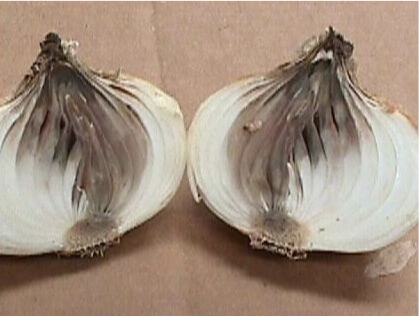
Figure 9. Reddish brown discoloration of onion scales caused by Botrytis neck rot.
Botrytis Neck Rot
Botrytis neck rot is the most damaging fungal disease affecting onions in Georgia with severe losses occurring both in the field and in storage. The fungus causing botrytis neck rot, Botrytis allii, can survive in the soil or on rotting bulbs as sclerotia. Botrytis conidia may arise from these sclerotia and be carried by wind to spread the disease.
Symptoms: Although the bulk of losses to botrytis neck rot are in storage, severe losses can be experienced in field situations. Plants infected in the field exhibit leaf distortion, stunted growth and splitting of leaves around the neck area. A grayish sporulation of the fungus may be observed between leaf scales near the neck area (Figure 8). In storage, infection can be internal with no discernible symptoms on the onion. It is not until onions are removed from storage that the infection becomes evident. Apparently the infection enters the neck and continues to grow undetected in storage until the onions are removed. It has been demonstrated that botrytis neck rot is not capable of sporulation in controlled atmosphere storage (high CO2, low O2, refrigerated storage), but continues to grow and destroy infected onion tissue. Infected tissue is sunken, water soaked and spongy with a reddish brown color (Figure 9). The grayish fungal sporulation can be seen between scales in infected bulbs. The gray mold will later appear on the onion surface and may give rise to hard, black sclerotia.
Management Options: Harvesting healthy mature onions with a well-dried neck will greatly reduce botrytis neck rot incidence in storage. Avoid over-fertilization and high plant populations which lead to delayed maturity and reduced air movement through the canopy, respectively. Curing onions with forced air heated to 98 °F will cause the outer scales to dry down and become barriers to botrytis infection. Storing onions near 34 °F at approximately 70% relative humidity reduces growth and spread of neck rot. Sanitation through deep soil turning and destroying cull piles helps reduce the amount of Botrytis allii inoculum in production fields. A combination of boscolid and pyraclostrobin as well as these products individually have been shown to give good control of botrytis neck rot. Using any fungicide should be integrated into a complete system of disease control. In addition, follow label direction for use. For questions on a specific program of disease control contact your local county extension agent.
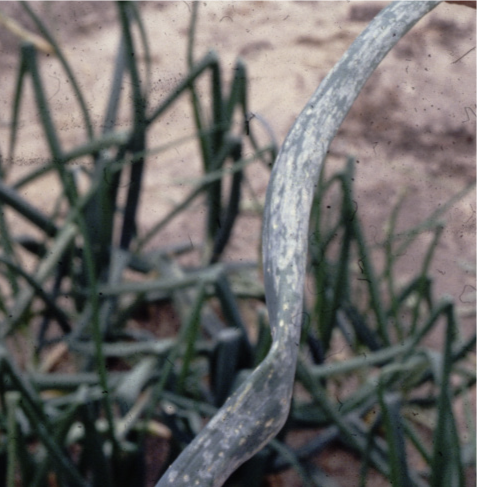
Figure 10. Pale lesions caused by Botrytis leaf blight.
Botrytis Leaf Blight
Botrytis leaf blight caused by Botrytis squamosa is another botrytis disease. However, this fungus infects onion foliage. This fungus survives in onion debris in the soil or in cull piles as sclerotia. The sclerotia produce conidia that become airborne and spread to foliage in production fields. Infection is greatly increased by long periods of leaf wetness and temperatures around 80 °F.
Symptoms: Initial symptoms of botrytis leaf blight are small (less than .25 in. in length) whitish, necrotic spots surrounded by pale halos (Figure 10). Spots often become sunken and elongated. Severely blighted leaves may result in reduced bulb size.
Management Options: Preventive spray schedules containing the fungicides maneb, mancozeb, and chlorothalonil are the primary means used to suppress development of botrytis leaf blight. In addition, iprodione, cyprodinil and fludioxonil, bocolid, and pyraclostrobin represent other materials that are effective against this pathogen that growers may wish to integrate into their disease management program. Destruction of cull piles, deep soil turning, and long rotations are also recommended to reduce losses to this disease.

Figure 11. Elliptical lesion characteristic of purple blotch.
Purple Blotch
Purple blotch, caused by Alternaria porri, is probably one of the most common diseases of onion and is distributed worldwide. The fungus overwinters as mycelium in onion leaf debris. During periods favorable for sporulation (leaf wetness or relative humidity of 90% or higher for 12 or more hours) inoculum becomes windborne and spreads to new foliage. Infection is highest at 77 °F. Older plant tissue is more susceptible to infection by purple blotch. Thrips feeding is thought to increase susceptibility of onion tissue to this disease.
Symptoms: Purple blotch symptoms are first observed as small, elliptical, tan lesions that often turn purplish-brown (Figure 11). Concentric rings can be seen in lesions as they enlarge. A yellow halo surrounds lesions and extends above and below the actual lesion itself for some distance. Lesions usually girdle leaves, causing them to fall over. Lesions may also start at the tips of older leaves.
Management Options: Long rotations to non-related crops, good soil drainage, and measures to reduce extended leaf wetness periods will reduce the severity of losses to purple blotch. Spray schedules which include mancozeb, chlorothalonil, and iprodione will suppress purple blotch. In addition, boscolid and pyraclostrobin are effective against this disease. These schedules should be intensified later in the season during periods of prolonged leaf wetness and high relative humidity.
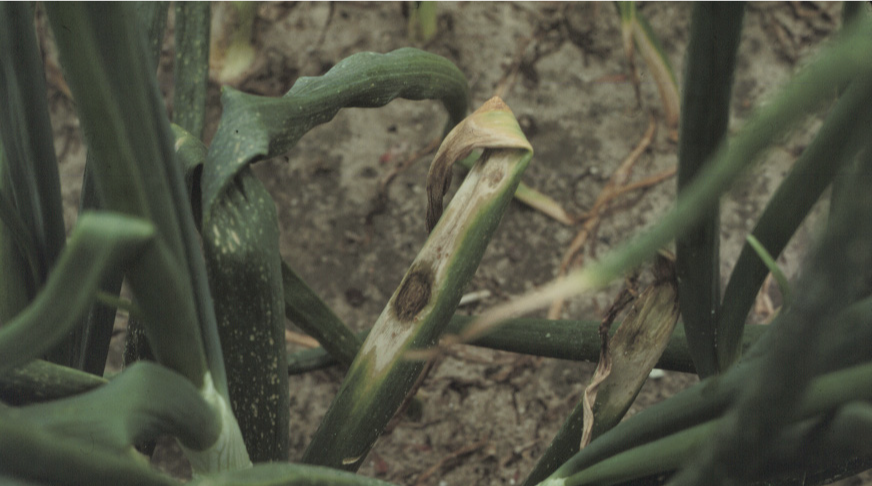
Figure 12. Dark sporulation indicative of Stemphylium leaf blight.
Stemphylium Leaf Blight
This fungal disease, caused by Stemphylium vesicarium, has become more widespread in the Vidalia onion growing region during recent years. This disease typically attacks leaf tips, purple blotch lesions and injured or dying onion leaves and is often identified as purple blotch. Disease cycle and epidemiology are similar to purple blotch. Stemphylium vesicarium, may enter purple blotch lesions causing a black fungal growth.
Symptoms: Since this fungus is usually found co-infecting with Alternaria porri, symptoms are identical or at least very similar to purple blotch. However, Stemphylium leaf blight lesions appear to contain a darker, more olive brown to black color than do purple blotch lesions (Figure 12). In the case of Stemphylium leaf blight, lesions are often more numerous on the sides of onion leaves facing the prevailing wind. These lesions grow rapidly, coalesce and cause severe leaf blighting during periods of prolonged leaf wetness.
Management Options: Practices used to suppress purple blotch will generally reduce losses to Stemphylium leaf blight. However, unlike purple blotch, the fungicide iprodione, boscolid, and pyraclostrobin are the only fungicide thought to be effective against Stemphylium leaf blight.
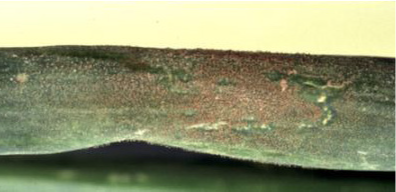
Figure 13. Velvety sporulation of the downy mildew fungus. Photo by Tom Isakeit, Texas A&M University, 1995.
Downy Mildew
Onion downy mildew, caused by the fungus Peronospora destructor, is very common throughout most areas of the world; however, it is rarely observed in the Vidalia onion growing region of Georgia. This fungus can overwinter in plant debris or be brought in on sets or seed. Temperatures between 50 and 55 °F, long periods of leaf wetness and/or high relative humidity (95%) are optimal for infection and spread.
Symptoms: Downy mildew may be first detected in the early morning as a violet, velvety sporulation (Figure 13). With time, infected areas of leaves become pale and later turn yellow. These lesions may girdle the leaf and cause it to collapse. Epidemics may begin in small spots in a field that will spread, mainly during periods of high relative humidity, and cause considerable defoliation.
Management Options: Management practices which ensure good airflow and adequate drainage will reduce the risk of high losses to this disease. Avoiding infected planting stock and destroying cull piles reduce available inoculum. Preventive application of fungicides provides the primary control of downy mildew in regions where it is a perennial problem. Fungicides such as mefenoxam, fosetyl-Al, chlorothalonil and mancozeb should be used at the first report of disease in the growing area.
Bacterial Diseases

Figure 14. Collapsed leaves caused by bacterial streak.

Figure 15. Dark green lesions caused by bacterial streak.
Bacterial Streak and Bulb Rot
This bacterial disease of onion, caused by Pseudomonas viridiflava, is a problem in the southeastern U.S. onion production areas. Disease is favored by excessive fertilization and prolonged periods of rain during the cool winter months of onion production.
Symptoms: Leaf symptoms initially appear as oval lesions or streaks that later result in the total collapse of the entire leaf (Figure 14). Initially, streaks are usually green and water-soaked but later cause constricted, dark green to almost black lesions near the base of infected leaves (Figure 15). Infected leaves will generally fall off the bulb when any pressure is applied to pull them off. A reddish-brown discoloration has been observed in the inner scales of harvested bulbs.
Management Options: Preventive application of fixed copper materials tank mixed with EBDC fungicides (Maneb, Mancozeb, Manzate, Dithane, Penncozeb and others) may reduce the incidence and spread of this disease. Avoiding over-fertilization with N during winter months may reduce losses to bacterial streak. Practices that reduce post harvest rot such as harvesting mature onions, curing onions immediately after clipping, and avoiding bruising or wounding will help avoid disease problems.


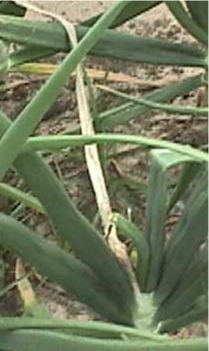
Figure 16. Bleached center leaves caused by the center rot pathogen Pantoea ananatis.
Center Rot
Center rot, caused by Pantoea ananatis, is another bacterial disease of onions grown in Georgia. Unlike bacterial streak, warm weather favors the development of epidemics of center rot. This bacterial pathogen is also found to be present in many weed species occurring in the Vidalia onion growing region.
Symptoms: Foliar symptoms of center rot are typically observed as severe chlorosis or bleaching of one or more of the center leaves of infected onions (Figure 16). Infected leaves are usually collapsed and hang down beside the onion neck. In harvested bulbs, reddish, collapsed scales near the neck area have been associated with center rot.
Management Options: As with bacterial streak, fixed copper materials tank mixed with EBDC fungicides are recommended to suppress infection and spread. Several onion cultivars have been documented to be more susceptible to center rot and should be avoided. Onions that mature early may avoid center rot losses by being less exposed to the higher temperatures necessary for the development of disease.
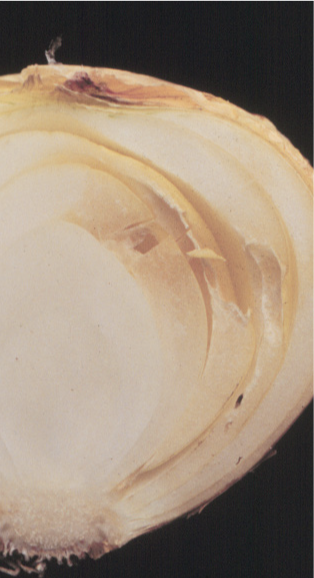
Figure 17. Onion bulb deterioration caused by sour skin.
Sour Skin
Burkholderia cepacia is the causal agent of this onion bacterial disease. Sour skin primarily affects onion bulbs but foliar symptoms may also be observed from time to time. This disease usually manifests itself during harvest when temperatures above 85o F are not uncommon.
Symptoms: Foliar symptoms, when observed, are similar to those of center rot. Scales of infected bulbs develop a cheesy or slimy yellow growth and brown decay (Figure 17). Infected scales may separate from adjacent scales allowing firmer inner scales to slide out when the bulb is squeezed. Sour skin infected bulbs usually have an acrid, sour, vinegar-like odor due to secondary organisms.
Management Options: Avoidance of overhead irrigation near harvest time will reduce losses to this disease. Also, use practices which reduce the chance of irrigation water becoming contaminated with the sour skin bacteria. Avoid damaging onion foliage prior to harvest as this provides wounds for the bacteria to enter bulbs.Do not allow mature onions to remain in fields during the warm climates associated with the later harvest season as infection and spread of this bacterium is enhanced with higher temperatures. Infected bulbs should be discarded before storing as disease can spread from infected bulbs to healthy bulbs. Infected onions should not be heat cured postharvest as this will rapidly spread this pathogen to uninfected bulbs. Storing onions in cool (32 °F) dry areas will prevent bulb-to-bulb spread of sour skin.
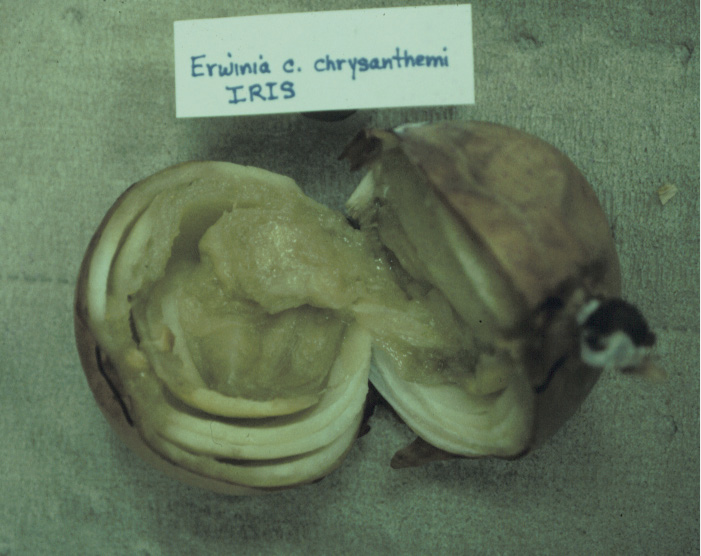

Figure 18. Deterioration of the core bulb scales caused by bacterial soft rot.
Bacterial Soft Rot
Bacterial soft rot, caused by Erwinia carotovora pv. carotovora, is a common problem in many vegetables, usually during storage. It usually develops in onions after heavy rains or after irrigation with contaminated water. This disease is primarily a problem on mature onion bulbs during warm (68–85 °F), humid conditions.
Symptoms: Field symptoms are very similar to those seen with center rot in that it causes center leaves of onions to become pale and collapse. Infected scales of bulbs are initially watersoaked and later appear yellow or pale brown. In advanced stages of infection, scales become soft and watery and fall apart easily. As the interior of the bulb breaks down, a foul smelling liquid fills the core area of the bulb (Figure 18). When harvesting, the tops of infected onions will pull off leaving the rotting bulb still in the ground.
Management Options: Avoid overhead irrigation where the water source has been potentially contaminated with soft rot bacteria. Application of fixed copper products may be marginally effective in reducing spread. As with most bulb diseases, harvesting mature onions, care in handling, and storage in cool dry areas will prevent post harvest losses.

Figure 19. Yellow bud of onion. Image by Ronald D. Gitaitis, University of Georgia, Bugwood.org.
Yellow Bud of Onion
Yellow bud (YB) is an emerging onion disease that has potential to severely affect Vidalia onion production. This disease was first observed in Georgia in 2007 and has since been spreading throughout the Vidalia onion-growing area in Georgia. However, to the best of our knowledge, this disease has not been reported elsewhere. The causal agent is a gram-negative, rod-shaped, aerobic bacterium that possesses all the phenotypic characteristics of Pseudomonas syringae. The yellow bud bacterium is possibly a pathovar of P. coronafaciens (as it is host-specific).
Symptoms: Symptoms of yellow bud include intense chlorosis in emerging leaves and severe blight in the older leaves. In time, yellow bud leads to stand loss, reduced bulb size, and may create possible avenues of ingress for secondary, soft rot organisms. The disease has also been observed in onion seed beds, thus infected transplants could be widely dispersed to areas throughout the Vidalia region or elsewhere. Occurrence of yellow bud in seedbeds may be an indication that the pathogen could be seedborne. There is evidence that this pathogen can be seedborne and seed transmitted in onion seeds.
Management Options: Preventive application of fixed copper materials tank mixed with EBDC fungicides (Maneb, Mancozeb, Manzate, Dithane, Penncozeb and others) may reduce the incidence and spread of this disease. This pathogen is also temperature sensitive and in most cases, yellowing symptoms subside with increase in temperature (> 55 °C).
Viruses
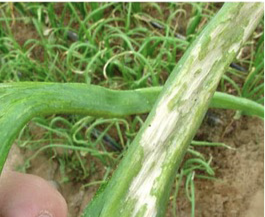
Figure 20. Yellow spot virus (IYSV)
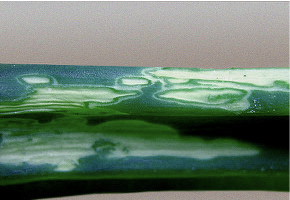
Figure 21. Tomato spotted wilt virus (TSWV).
Iris Yellow Spot Virus (IYSV) and Tomato Spotted Wilt Virus (TSWV)
Recently these viruses have been detected in onions, but it is unclear if they are or will become a major disease in onions. TSWV has been a major disease in other crops in Georgia for many years. IYSV is known to be pathogenic on onions, which has become a major disease in other onion producing regions particularly in the western U.S. and particularly on onion seed crops. IYSV is spread by onion thrips (Thrips tabaci), which surprisingly are not generally found in Georgia. Recently, however, this virus has been detected in Tobacco thrips (Frankliniella fusca), which is widely distributed in Georgia.
These viruses can be detected in onions that are otherwise symptomless. These latent infections may never become a problem or symptoms may develop when onions are stressed such as during cold weather, during and after transplanting, or some other stress condition. It is unknown, however, if this does occur.
Symptoms: There is not enough information available to clearly identify symptoms associated with these virus infections. Small necrotic spots with green tissue remaining in the center may be symptom expression. This has not always been correlated with detection during laboratory screening.
Management Options: Since these viruses are spread by thrips, thrips control may help control infection. Typically thrips control (see insect section) has been important during late winter and early spring, but with the detection of these viruses, growers should begin scouting onions in the fall and early winter for thrips, taking necessary action when they appear. Since stress may be a factor in symptom development, care should be taken to minimize stress. Proper fertilization, water, and control of other diseases may be important. Obviously transplanting shock and cold weather are unavoidable, but it may be helpful to avoid transplanting onions just prior to colder temperatures. If cold weather is expected it may be wise to delay transplanting until the cold has passed.
Registered fungicides:
-
mancozeb & maneb Dithane, Manzate, etc.
-
chlorothalonil Bravo, Echo, Equus
-
iprodione Rovral
-
cyprodinil + fludioxonil Switch
-
fixed copper
-
mefenoxam
-
fosetyl-A1 Aliette
-
pyrimethanil Scala
-
mefenoxam + chlorothalonil Ridomil GoldBravo
-
mefenoxam + copper Ridomil Gold/Copper
-
mefenoxam + mancozeb Ridomil Gold MZ
-
mancozeb + copper ManKocide
-
boscolid + pyraclostrobin Pristine
-
boscalid Endura
-
dimethomorph Acrobat
-
azoxystrobin, pyraclostrobin Quadris/Amistar, Cabrio
Known effectiveness of registered fungicides:
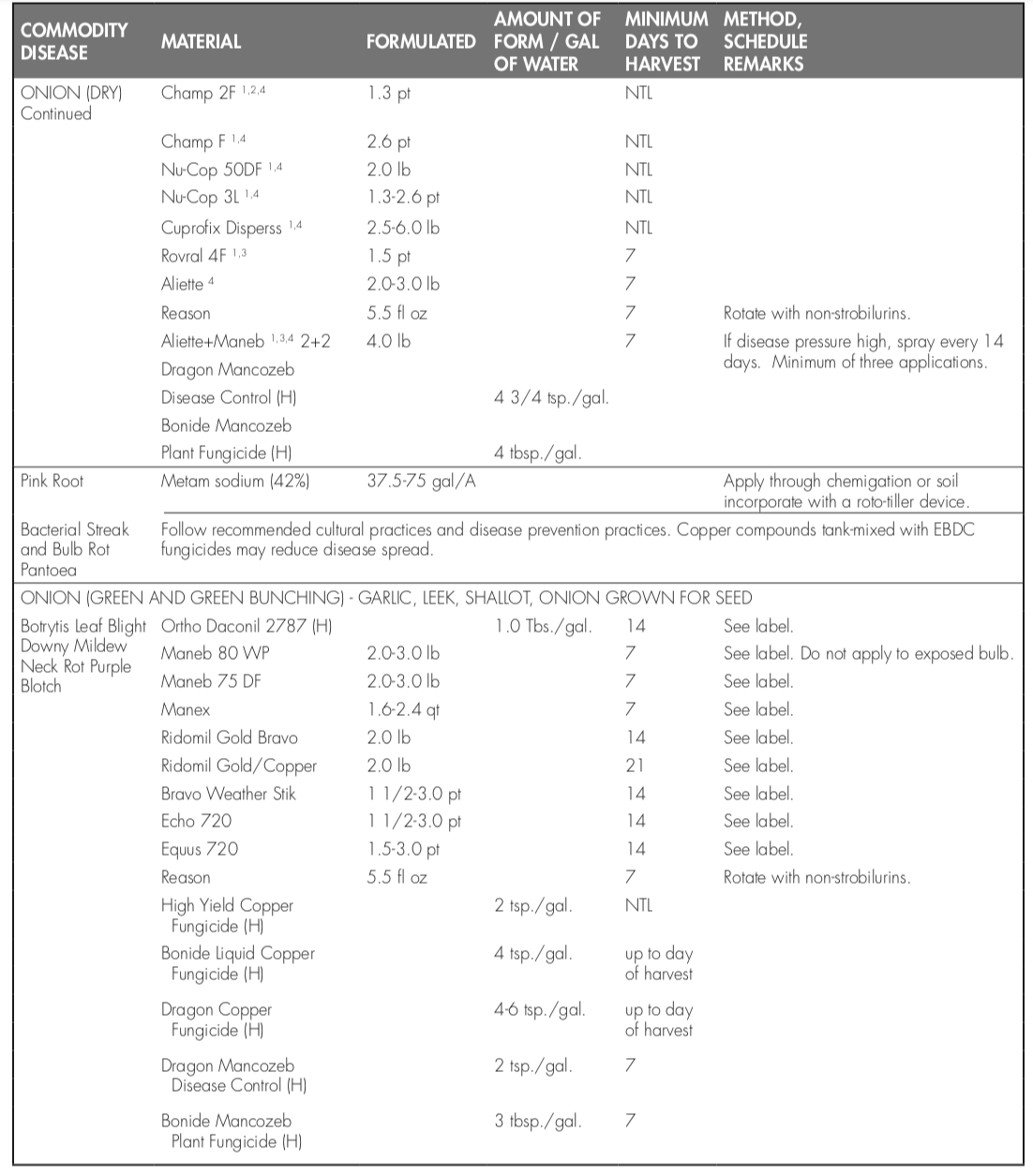
1Information in this table was partly derived from ratings given at the IR-4 Bulb Vegetable Crop Group Workshop held during the 1999 American Phytopathological Society annual meeting in Montreal, Canada. Ratings for products does not necessarily indicate a labeled use.
C = When used in combination with mancozeb
V = Variable levels of control
R = Pathogen resistance (insensitivity) may be present at some locations
E = Excellent disease suppression
G = Good disease suppression
F = Fair disease suppression
P = Poor to no disease suppression
U = Unknown efficacy
VEGETABLE DISEASE CONTROL


ONION INSECTS AND THEIR CONTROL
Since onions are a winter crop in southeast Georgia, insect problems are not as severe as they would be for spring, summer, or fall crops. Preventative measures and careful scouting can minimize or eliminate any potential problems.
Soil borne insects such as cutworms, onion maggots, wireworms, and others can be controlled with preplant applications of an appropriate soil insecticide (Table 7). Application should be made just prior to seeding plantbeds as well as just prior to transplanting to final spacing.
Onion maggots (Delia antiqua) can be a severe pest in more northern states. The seed corn maggot (D. platura) is much more common in Georgia and generally does not cause as much damage as the onion maggot. The adults of both species are flies similar to, but smaller than houseflies. Adults lay their eggs in the soil near seeds or seedlings and the hatching larva feed on the developing plants. Seedcorn maggots can reduce plant stands in seedbeds, as germinating seeds and small seedlings can be killed. Once plants are established, seedcorn maggots are not likely to cause plant mortality, but may be associated with dead and decaying plants as these plants are attractive to the maggots, which will feed on most decaying plant material. It is also not uncommon to find large populations in fields shortly after severe frost damage. The frost damage results in an abundance of decaying organic matter in the fields, which is attractive to seed corn maggots. Seed corn maggot can be a problem late in the season as a contaminant in harvested bulbs. While they likely cause minimal damage to bulbs, the pupae can be tightly attached to and transported with bulbs, resulting in adult fly emergence in unwanted locations. To avoid stand loss from seed corn maggots, fields should be plowed early to reduce the amount of fresh organic matter in the soil and/or care should be taken to thoroughly treat the soil with an appropriate insecticide.
Cutworms, wireworms, and other soil insects are frequently present in fields before planting. These insects tend to be more of a problem in fields that have been fallow (with abundant weed hosts) or in turf. Proper weed sanitation and field preparation several weeks prior to planting or transplanting can reduce problems with soil insects. Where soil insect problems are anticipated, preventative treatment with a pre-plant insecticide is recommended (Table 7).
Cutworms are the larval stage of many species of moth in the Noctuidae family. These caterpillars generally feed at night and hide during daylight hours. Damage generally is detected as plants cut off near the soil line. Their nocturnal habits and cryptic coloration make them difficult to find, which is required for proper diagnosis of the problem. These pests are more easily detected by examining plants very late or very early in the day. See Table 7 for appropriate control measures.
Wireworms are the larval stage of click beetles. There are several species of these insects, which may attack onions. Eggs are laid in the soil and the larva feed on below ground portions of plants. While some species have multiple generations in a year, others are capable of living as larvae for 1 to 2 years before pupating and becoming adults. See Table 7 for appropriate control measures.
Thrips are the primary insect pest of onions. Thrips have rasping mouthparts that cause physical damage to the onion leaf. Damaged leaves are more susceptible to subsequent disease infection as well as being less efficient at photosynthesis. While these insects can appear in the fall, they are much more common in late winter and early spring as temperatures increase. Populations of thrips and the severity of this insect problem on onions can vary considerably from year to year. When considering direct damage to onions, careful scouting of plants should begin shortly after the beginning of the year. Special attention should be given to leaf folds and down in the ‘neck’ of the plant. Thrips have a strong preference for these ‘tight’ areas that provide protection and will congregate at these locations.
Spraying for thrips should begin when an average of five thrips are present per plant. However, research has indicated that a single spray of an effective insecticide when there is one thrip per plant can reduce subsequent thrip populations and reduce the number of subsequent insecticide sprays. Spraying within 2 weeks of harvest for thrips control does not appear to provide any benefit in terms of yield even if the threshold is exceeded. Thrips reduce yields in onion by reducing bulb size, thus, once the bulb has reached full size, thrips damage is inconsequential to yield. However, thrips may transmit some onion diseases and control near harvest may affect bulb quality.
Insecticide resistance in thrips populations is an ever present threat and the different species of thrips may respond differently to specific insecticides. Excessive use of insecticides or use of ineffective insecticides only increases the presence of insecticide resistance. Thus, when sprays for thrips are made, then they should only be made in response to thrips populations exceeding the threshold, and species identification should be made prior to insecticide selection. It is also important to keep track of which insecticides are currently effective.
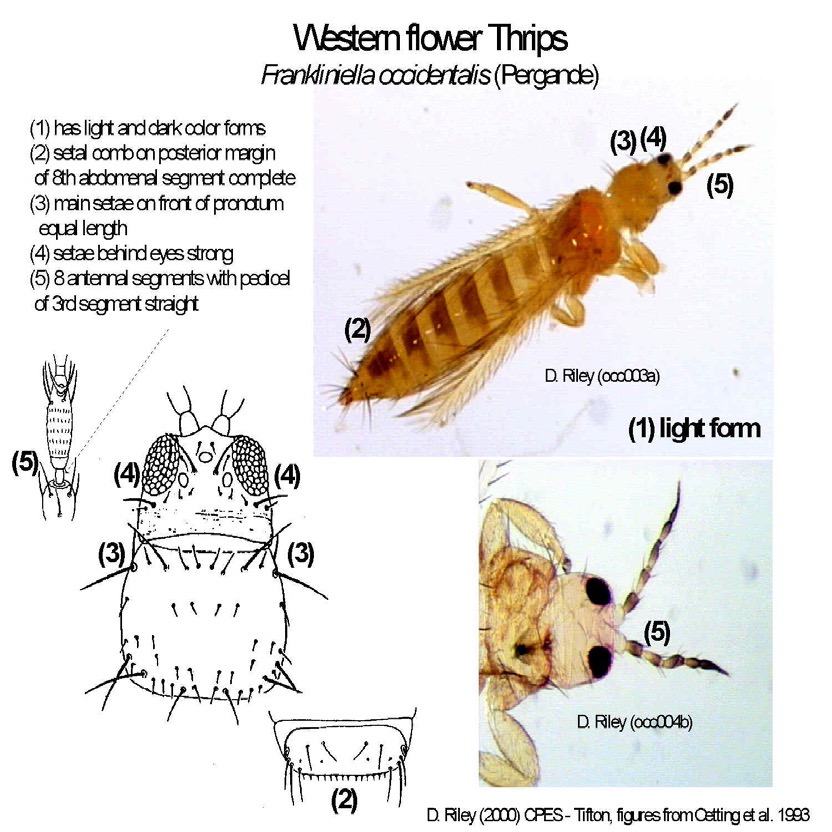
Figure 22. Western flower thrips.
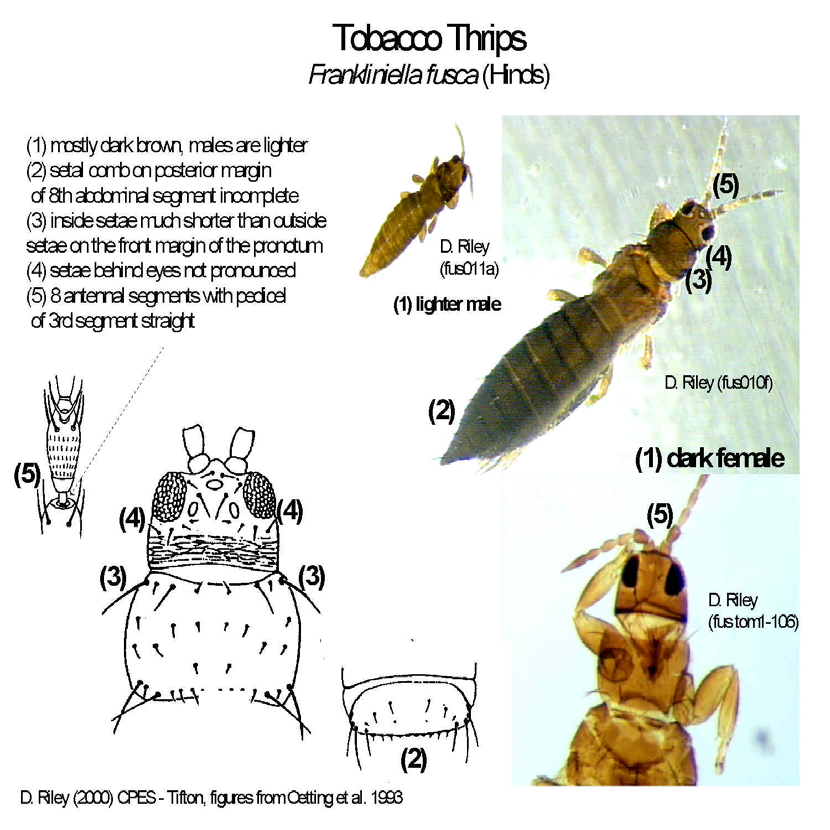
Figure 23. Tobacco thrips.
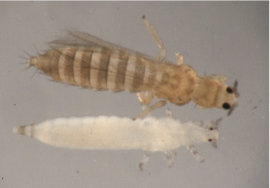
Figure 24. Onion thrips.

Figure 25. Onion thrips on the left and western flower thrips on the right.
There are three species of thrips that can be are prevalent on onions in the Vidalia region; Western flower thrips (Frankliniella occidentalis) (Figure 22), Tobacco thrips (Frankliniella fusca) (Figure 23), and Onion thrips (Thrips tabaci) (Figures 24 and 25). In recent years, the tobacco thrips has been the predominated populations in the Vidalia production region, and pyrethroid insecticides have performed well against this species. However, in the 2006-2007 production season, onion thrips were found to predominate in some areas, and pyrethroid insecticides preformed poorly against this species.
In addition to direct damage to onions, thrips serve as vectors of viral diseases and have been implicated in transmission of other onion diseases. As mentioned in the Disease section, scouting and control of thrips may be necessary during the fall and early winter to control potential outbreaks of IYSV and TSWV. Onion thrips, which traditionally have not been very important in southeast Georgia, are the major transmitting vector of IYSV. If they become more prevalent, the potential for IYSV outbreaks will increase, and may require additional control of thrips
Table 7. Insect control suggestions for onions.


ONION WEED MANAGEMENT
Managing weeds is critical for successful onion production. Weeds compete with onions for light, nutrients, water, and space. In addition to reducing harvestable bulbs through competition, weeds have been shown to interfere with the harvesting process by decreasing efficiency. Weeds can also harbor destructive insects and diseases that can severely damage the present or subsequent crop.
There are several weed species that commonly infest onion. The most common and troublesome weeds are highly influenced by planting time. It is more likely that summer annual weeds will impact management decisions when onions are planted earlier in the fall season. As plantings are delayed, summer annual weeds become less of a concern. Summer annual weed species that will most likely impact onion production include Texas panicum, sicklepod, nutsedge, pigweed, purslane, morning glory, crabgrass, and Florida pusley. Infestations of winter weeds often include cutleaf evening primrose, swinecress, henbit, Virginia pepperweed, shepherd’s-purse, wild radish, and common chickweed.
Methods of Weed Management
A diversified approach integrating cultural, chemical, and mechanical control measures often achieves the most success.
Crop Rotation
Crop rotation aids in managing weeds as well as many other pests. Annual and perennial grasses are relatively easy to control in onion through the use of various herbicides. However, controlling certain broadleaf weeds and nutsedge species is much more difficult. Therefore, control of difficult weeds may be best obtained through rotating into another crop where these problematic weeds can be controlled more easily and more effectively. In addition, rotation to other crops allows the application of different herbicides on the same field in different years. Thus, the grower can reduce or prevent buildup of problem weeds and help keep the overall weed population at lower levels.
Hand-Weeding
Hand-weeding effectively controls most weed species, although nutsedge can be quite challenging. Weeding by hand should be conducted when both the crop and weeds are small in order to reduce crop damage and to allow for the use of mechanical tools such as hoes. Removal of large weeds with extensive root systems may damage onion roots or foliage. Although hand weeding is very effective, it also may be very expensive because of time and labor requirements.
Stale Seedbed
The stale seedbed technique employs a non-selective herbicide such as paraquat or glyphosate to kill emerged weeds before planting onion. In the stale seedbed method, the seedbed is prepared several weeks before planting. Weeds are allowed to emerge and are then killed by the non-selective herbicide. The crop is then planted at the appropriate time with minimal soil disturbance to prevent stimulation of weed germination. A second method of stale seedbed weed management that does not include the use of herbicides involves light/shallow cultivation of the desired area several times as weeds emerge before planting.
Fumigation
Fumigation can provide substantial weed control but must be applied by trained personnel. Metam sodium is the most commonly used fumigate applied, mostly for seedbed production. At the full use rate of metam sodium (Vapam HL at 75 GPA, other products are available), many broadleaf and grass weeds are effectively controlled while suppressing nutsedge species. However, large seeded weeds with hard seed coats like morningglory are often not controlled. Appropriate soil conditions including no soil clods, moisture at field capacity or slightly wetter and soil free of debris including plant material is absolutely essential for an effective fumigation. Additionally, the overhead use of irrigation after application can effectively seal the fumigant in the soil for improved control. The length of time needed for the fumigant to be sealed in the soil varies and one should read and follow restrictions provided on the label of the product used. Fumigation can be expensive and is often only used for seedbed production.
Herbicides Programs
Planning Your Herbicide Program: Soil characteristics (such as soil organic matter and texture), herbicide capabilities and limitations, herbicide application methods, and expected weed species should all be determined prior to selecting your herbicide program. Additionally, understanding herbicide carryover from previous crops is critical. Some herbicides used in crops rotated with onion pose a significant threat to onions and these concerns must be addressed prior to planting. Always read labels for crop rotational restrictions.
Mapping: Knowing what weeds will be present in the onion field can greatly increase the potential for successful weed management. This is best accomplished by weed mapping. Survey fields and record on a field map the weed species present and their general population levels at harvest. Those species present at harvest will most likely be the predominant problem weeds next season. Additionally, by referring to weed maps over a period of years, one can detect shifts in weed populations and make adjustments in herbicide programs to manage these weed shifts as they occur. Proper weed identification is necessary since weed species respond differently to various herbicides.
Monitoring: Fields should be monitored periodically to identify the need for postemergence herbicides. Even after herbicides are applied, monitoring should be continued to evaluate the success of the weed management program and to determine the need for additional control measures.
Herbicides Options In 2017: Preplant applications for dry bulb or green onions include paraquat and glyphosate (Table 1). Both of these tools are non-selective herbicides that will kill most problematic weeds prior to planting, assuming weeds are small and applications are timely. Glyphosate will not control resistant pigweed or primrose; thus, a sequential application of glyphosate followed by paraquat may be in order.
Currently the only preemergence herbicide option for seeded onion includes Dacthal (Table 1). Dacthal rate should be selected carefully as onion stunting can occur at higher use rates. Additionally, weed control with Dacthal is marginal at best.
Postemergence applications for both dry bulb and green bulb onions include Dual Magnum, Outlook, and Poast. Poast is an excellent tool to control emerged annual grass weeds while Dual Magnum and Outlook will provide residual control of small seeded-broadleaf and grass weeds. Proper application timings for Dual Magnum and Outlook are critical, (Table 1). Additional postemergence tools are available for dry bulb onions including Prowl, Goal, Select, and Fusilade DX. Select and Fusilade DX, similar to Poast, provide excellent control of annual grasses but these two products also provide fair control of perennial grasses such as bermudagrass. Prowl and Goal are the backbone herbicides for all effective dry bulb onion production systems. Prowl provides residual control of small seeded grass and broadleaf weeds while Goal provides both residual and postemergence control of many of the most problematic weeds infesting onions such as pigweed, primrose, and wild radish.
Weed Management Systems
Seedbed: The most effective program for seedbed production begins with a fumigant application of metam sodium. Utilize glyphosate 3 days prior to seeding to control weeds that have escaped the fumigant application and/or apply paraquat any time prior to onion emergence. It is critical that no weeds are emerged at time of planting. Dacthal is the only PRE emergence herbicide option and should be applied after seeding followed by irrigation for activation.
Dry Bulb Transplant Production: Weed control is transplant onions begins buy transplanting onions into fields free of weeds; tillage, glyphosate or paraquat can all be effective options to achieve this objective. Irrigation to seal the soil around the root ball after transplanting is critical followed by an application of Prowl plus Goal within 2 days of transplanting. An additional, activating irrigation/rainfall is preferred within 2 days of the herbicide application. Do not apply Goal with a surfactant, fertilizer, or other chemical. If needed, Dual Magnum or Outlook can be added to the program for additional residual control (Table 8).
Dry Bulb Seeded Production: Weed control in seeded onion production is among the most challenging of any crop grown in Georgia. Currently programs often do not provide adequate weed control without the use of fumigation, which is very expensive. Metam sodium as a preplant fumigant, Dacthal preemergence, and sequential postemergence applications of Prowl, Goal, and Dual Magnum during their appropriate application windows offer the best chance for success. Applications are often need on bi-weekly intervals and often control is not adequate throughout the entire crop season.
Prowl may be applied postemergence to onions, but will only control weeds if activated prior to their germination. Prowl is most effective on annual grasses such as crabgrass, crowfootgrass, and Texas panicum and broadleaf weed species such as common chickweed, pigweeds, Florida pusley, as well as cutleaf evening- primrose suppression. Apply Prowl to direct-seeded onion in the 2 to 9-leaf stage of growth.
Goal controls many annual broadleaf weeds through postemergence and residual activity. Goal may be applied in onion fields to effectively control wild radish, swinecress, shepherd’s-purse, cudweed, and evening primrose. Emerged primrose is often difficult to control with Goal; however, Goal applied prior to primrose emergence is usually very effective.
For seeded onion, use low rates of Goal 2 XL (approximately 3 to 4 oz/A broadcast) or Goal 4F (approximately 1.5 to 2 oz/A broadcast) and apply to onion in the 3 to 4 leaf stage. When onion has 4 or more true leaves, Goal 2 XL rates can often be increased to 6 to 8 oz/A while Goaltender 4F rates can be increased to 3 to 4 oz/A. For Goal to be effective against cutleaf evening primrose the weed should not be any more than 0.25 in. in diameter.
Table 8. Herbicide options for onions.


HARVESTING, CURING, AND STORAGE
Bulb quality is the most important factor when producing a marketable product. To ensure maximum quality, onions should be artificially cured. Artificial curing allows the grower to have better control over the curing process. During years when excessive rains and unfavorable drying conditions occur in the field, artificial curing will be required.
Harvesting
Onions should be harvested at optimum maturity. Maturity is best determined by pinching the neck of the growing onion. Necks of immature onions are stiff, whereas necks of mature onions are soft and limber. Early varieties are strongly daylength sensitive and thus are more likely to break over at the neck early and uniformly. These onions can be left in the field in this condition for up to a week without detriment under most conditions (no heavy rains). Later maturing varieties may show 20-50% of their tops broken over at the neck for optimum maturity. In some years this may not occur because the onions have developed a thicker neck. This is usually associated with mild winter weather. Simply observing the percentage of tops having fallen over is not a true indication of maturity, since the tops can be knocked over by strong winds, rain or become limp from lack of moisture. Onions should be carefully examined for softness in the neck and large bulb size to indicate time to harvest. Late varieties are highly susceptible to warm weather bacterial diseases and may require harvest before optimum maturity to prevent widespread infection with bacterial diseases.
Onions should be undercut with a rotating bar or fixed blade when mature and necks are soft and limber. The blade or rotating bar should operate at approximately 1 in. below the bulb, so as not to damage their base. A rope is often dragged across the top of the onions at the same time to roll the onions out of the ground and expose the roots. Every effort should be made to prevent excessive bulb exposure to the sun which will cause the onion to blister therefore onions should be gathered within a few days of undercutting. If light rain occurs during field drying, the onion beds should be undercut a second time. This will break soil that has been re-attached to the bulb.
After onions have field dried for 3 to 5 days under sunny dry conditions, the roots and tops of the onions should be removed. Tops are cut at approximately 1.5 to 2.0 in. above the bulb and roots cut off completely. Extra short necks increase the likelihood of disease infection. During clipping, care should be taken to prevent injury to the bulbs with the shears and by dropping the bulbs on to hard surfaces such as the bottom of buckets and other onions. Hand harvested bulbs can be placed into burlap or mesh bags in the field and transported by truck to packing sheds. Another method has them placed in large bin boxes that are moved by forklifts to trucks for transport to packing sheds. Onions should always be carefully handled to avoid external and internal damage, especially when loading onto the hard surface of truck bodies. Walking and standing on bags of onions should be avoided. The bulbs should be placed in bins or boxes with at least 6% vent space. The bins should be immediately placed on a drying system. Remaining roots will shrivel during curing and will be knocked off on the packing line. Necks should dry during curing and fold over when handled.
Research and field demonstrations indicate that sweet onions can be harvested using a mechanical harvester. Sweet onions are undercut as usual in the hand harvest production system. They are allowed to field dry for 3 to 5 days. The harvester lifts the onions onto an elevator chain and the soil is separated from the onions. When the onions have reached the top a fan pulls the leaves into a vertical plane and the leaves are cut off. Tops are deposited onto the ground and bulbs are conveyed into a trailer or bin. The onions are transported to the packing facility and passed through a mechanical topping machine which removes the remainder of the tops left by the harvester. Neck length is approximately 1 to 1.5 in. After leaving the topping machine, the onions are graded for quality and size and placed in mechanical dryers for curing. Storage studies indicate that shelf life is the same for machine harvested and hand harvested mature onions.
Onion Curing
Onions are cured in order to extend their shelf life. An onion bulb is a series of concentric swollen leaves still attached to a short stem or base. These are surrounded by scales which are dried leaves. Curing of onion bulbs serves several functions. First it dries the outer two to four scales providing mechanical protection. It dries those roots remaining attached to the bulb following undercutting and the neck left attached to the crown following topping, deterring disease infection. Lastly, curing encourages dehydration and the sealing of wounds that may have resulted during bulb growth or mechanical damage. The term “curing” rather than “drying” of onions is preferred because the removal of moisture is limited to the parts mentioned while protecting the high moisture content of the flesh inside the bulb. This differs from “drying” other commodities such as peanuts or grain, where moisture is removed from inside the seed or kernel. Onion bulbs consist of a high proportion of water (approximately 90%) and desiccation of the bulbs must be avoided.
Moisture is removed from the skin, roots, and stem of onion bulbs by dry air blown over them. The onion skin dries and becomes uniform in color, exhibiting a brittle texture. The roots shatter or break off easily when touched. The stem area should shrink in size and be dried to the surface of the bulb. It should not slide back and forth when squeezed between the thumb and forefinger. Once the onion has cured properly, the outer leaf scales will help retain internal moisture and protect the onion during shipment.
The curing of sweet onions with forced air involves the following parameters. The air temperature should be maintained between 97 to 100 °F. The airflow should be 365 to 1,030 CFM/ton of sweet onions. Linear air velocity should be 15 to 21 ft/min through the stack of onions. The less airflow capacity the longer it will take to cure the onions. Relative humidity should be maintained at approximately 50% to 65%. There are two types of artificial curing systems being used: batch and re-circulating forced air.
Batch curing is the most common type of curing system, consisting of the heating of outside air and forcing it through a stack of onions with the air exiting to the outside environment. It is difficult to control humidity with this system because conditions of the outside air vary. For batch curing with an airflow rate of 780 CFM/ton of onions with a 35 °F rise in air temperature the heater should have the capacity of 30,030 BTU/hr per ton of onions. To allow air movement away from the onions, an air space of 25 ft above the top bins is required.
Re-circulating forced air curing involves recirculating the air within a chamber that passes around the onions. Stacking the onion bins in two rows to form a tunnel and pulling air through is also called forced air curing. Temperature and relative humidity are much easier to maintain giving the operator more control over the curing process. Air may either be forced or pulled through the onions. Moisture-saturated air exits the facility by vents and is replaced by incoming, dry air. The supplemental heat required for re-circulating air curing is 3,500 BTU/ hr per ton of onions. These calculations are based on minimum 65 °F environmental temperature and 99 °F curing chamber temperature.
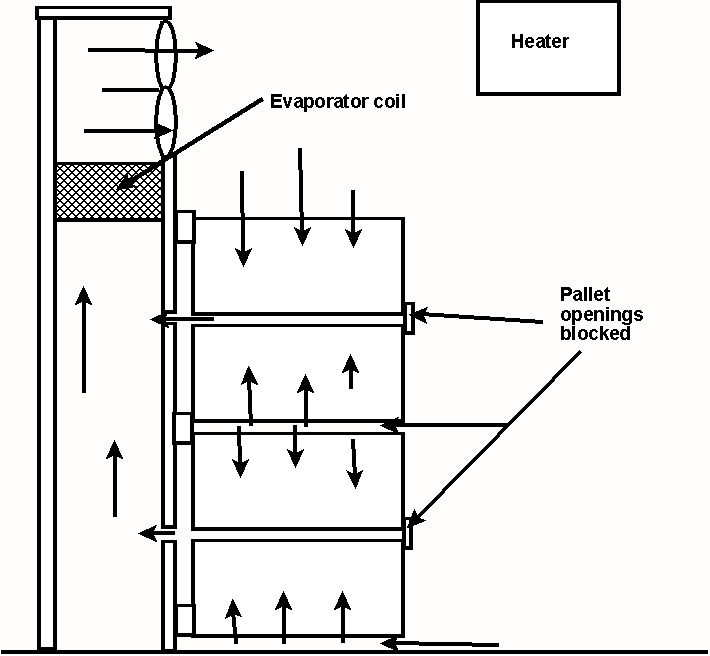
Figure 26. Onion curing.
Air movement is very important to curing onions. The air must move around the onions and not escape through cracks in between bins or boxes. The fork lift space below bins and handle areas of boxes should be closed off with strips of plastic or canvas to stop airflow through these areas. When air is being pushed through the containers, a more rigid material like wooden panels should be used. The fan framing should be placed tightly against the containers to eliminate any loss or escape of air (Figure 26).
Onions are generally cured for 24–48 hr prior to final grading and packing. This may vary depending on the condition of the onions. Onions should be sorted and inspected immediately following curing before shipping or storage. If the onions are left unattended for more than 1 week, they should be inspected again since diseased onions are likely to infect other onions during shipping or storage. Fresh market onions should be in the hands of the consumer within 4 weeks of harvest. Onions destined for cold or controlled atmosphere storage should be sampled and analyzed for disease before storage in order to remove infected bulbs. There is no point in storing onions which are already infected.
In some cases onions may be cured solely in the field. Under favorable weather conditions, onions can be left in the field for 5–7 days after undercutting. Care should be exercised with this process since onions are subject to sun damage if left in the field too long.
Late maturing and late harvested onions can be more prone to late season warm weather bacterial diseases such as sour skin and slippery skin. Care should be exercised not to harvest such onions and they should not be co-mingled with uninfected onions particularly during curing. The heating process of curing will rapidly spread the bacteria throughout all the onions.
The storage method chosen is dictated by the market window being targeted—i.e., fresh blown air, air-conditioned, cold, or controlled atmosphere. The method of storage influences the rate of decay, but will not stop it. Onions going onto the market following the fresh market window may be kept in cold storage, but should be placed into cold storage within 1 week of being undercut. Any delay encourages disease growth. Two types of damage occur during the handling of onions. Surface injuries are made in the field by cuts, punctures and wounds with snips and fingernails. Bruising injuries are made by impact shocks or vibration damage in the field or at the packing shed. Surface injuries are obvious, but bruising is more subtle, often not showing up until after the onions leave the shed. It is important to recognize the significance of bruising as it relates to onion quality and shelf life. Bruising causes superficial cracks in the outer scales of onions, allowing bacteria and mold organisms to penetrate and break down the internal tissues, resulting in decay. Evidence of poor handling is seen as bacterial soft rot and various mold rots at the terminal or retail markets.
Better supervision of workers’ activities during harvesting and subsequent loading operations usually reduces bruise damage in sweet onions. Careless topping or cutting of roots leads to surface wounds and decay. Shock damage occurs when bags are thrown onto flatbed trucks and pressure bruising results when workers stand on lower bags to load or remove higher bags. Bruise damage is most serious at the packing shed, occurring as individual onions move across grading equipment. Product damage can be reduced if equipment is designed and installed properly. Damage also occurs during unloading. Workers characteristically slam burlap bags onto wooden or metal surfaces during onion unloading. The onion’s weight multiplied by this velocity equals a substantial damaging force, so damage increases the speed at which onions fall. Padding these areas will reduce impact injury which, results in less bruising. Unloading is but the first of many ways onions receive shocks on a packing line. Based on preliminary work done to pinpoint potential damage sites, there are at least eight stages in a typical line that inflict onion bruising. A simple investment in foam padding or insulated carpeting for these potential damage points can increase the pack-out yield.
For the following recommendations to work, onions must first be in sound condition at harvest. Bulbs with internal decay cannot be suitably cured and can cause decay of adjacent bulbs during curing and storing.
Onions are graded and put into 3-, 5-, 10-, 25-, 40-, or 50-lb bags or boxes. Grading consists of sizing and removing rotten, damaged or off-type onions. Onions can be sold immediately or stacked in a dry area with good air circulation. Early short-day onions do not store well and should be moved to the market within a few days of harvest.
To improve storability:
-
Harvest only mature onions.
-
Do not over fertilize onions.
-
Withhold nitrogen fertilization 30 to 45 days before harvest and irrigation 1 to 2 weeks before harvest.
-
Harvest and handle onions carefully to avoid damage.
Do not hold onions any longer than necessary. Market them as soon as possible. Vidalia onions are required to be inspected by USDA inspectors in order to use the Vidalia name. Vidalia onions are graded into three grades; U.S. No. 1, U.S. No. 2, and U.S. Combination grade. They are also graded into size classes (Table 9). For more complete information on grading Granex onions, obtain the ‘United States Standards for Grades of Bermuda- Granex-Grano Type Onions’ from the USDA. This publication is also available on the web at www.ams.usda.gov/standards/. The USDA grade standards lists a ‘small’ (1–2.25 in.) and ‘pre-packer’ (1.75–3 in.) grade size, but these are never marketed as Vidalia onion.
Table 9. USDA size grades for Bermuda, Granex, and Grano type onions.
| Grade Size | Minimum Diameter (inches) | Maximum Diameter (inches) |
| Medium | 2 | 3.25 |
| Large or jumbo | 3 | No requirement |
| Colossal | 3.75 | No requirement |
Control Atmospheric Storage Requirements
Cold storage conditions recommended for onions in the USDA Handbook 66 are a temperature of 32 °F and a relative humidity of 65% to 70%. The handbooks indicate that a RH of 85% has been satisfactory with forced air circulation.
Research has shown that properly cured and decay-free sweet onions stored in a controlled atmosphere (CA) containing 5% carbon dioxide, 3% oxygen, and 92% nitrogen for up to 5 months at 34 °F, 70%–85% RH. These onions had good quality and shelf life when removed from CA storage.
There are several conditions that must be met for a CA facility to work properly. The building must be air and moisture-tight. Several types of building construction are suitable for CA storage rooms.
The construction must provide:
-
An absolute vapor barrier to prevent moisture migration into the CA room;
-
Adequate insulation (25-30 R-walls, 30-40 R-ceiling);
-
Air-tight conditions (the room should hold one-half pressure; pressure change from 0.8 to 0.4 or from 0.6 to 0.3 in. of water). A leaky room will require excessive nitrogen and carbon dioxide additions. Leaks around the door and improperly sealed penetrations are major contributors to a poorly sealed room.
-
The CA room should be protected from wind and direct contact with sunlight and rainfall to prevent extremely rapid changes in temperature that may cause rooms to leak.
-
Each room must have a vacuum-pressure release valve and be equipped with an air bag to prevent atmosphere loss when minor fluctuations in room pressure occurs. A large air bag may be needed for onion CA rooms due to large air volume increase during evaporator defrost cycle.
-
Rooms should be interconnected (with PVC piping and valves) to allow more efficient CA establishment and pressure normalization. Room interconnections are especially important for small rooms.
-
Calculations show that a large CA door (12.5’ X 16’) can increase room capacity by 400-600 bags and rapidly offset the additional cost of the larger door.
The storage temperature must be maintained at 34 °F. Some portions of sweet onions may freeze at 30.8 °F. Freezing damage appears as water soaked outer scales when thawed onions are cut. A temperature of 34 °F with variations of 1 °F or less should prevent freezing. Each storage room should have at least two evaporator units with one condenser unit (sized to meet room heat gain) equipped with reheat. The defrost cycles of the evaporators should be staggered with room PVC piping interconnections among rooms to serve as atmosphere expansion/contraction buffers. A back-up cooling system may be advisable.
Air storage circulation should be maintained at 100-200 cfm//ton of onions. Forced air circulation is needed to keep temperature and relative humidity conditions uniform throughout the CA room. Fans should be placed at the rear of the room (opposite from entrance door), draw air through the pallet openings of the bins into a plenum area, and then blow it over the cooling and dehumidification units attached through the roof of the CA room. Stack bins to ensure continuity of the pallet box forklift openings for the entire length of the stack in line with airflow. Variable fan speeds controls will help attain uniform RH conditions throughout the room. Begin operating fans when the first onions are placed into each room and continue until the last onions are removed.
Relative humidity should be maintained at 70%-75%. Sweet onions will lose weight in CA storage at a rate of 1% to 1.5% per month. In a 10,000 bag storage room this represents a water generation rate of 5,000-7,500 lb per month or 7-10 lb per hour. The dehumidification system must be capable of removing this amount of water without significantly affecting storage temperature. Operation of dehumidification units is controlled by a humidistat. Improper control of relative humidity, air circulation, and temperature can cause a complete loss of sweet onions during storage.
The oxygen concentration should be maintained at 3% in the room. The low oxygen level is attained by flushing the room with nitrogen gas. Nitrogen can be obtained by on site generation with a membrane, a pressure swing absorption N2 generator, or through use of liquid nitrogen. All three sources of nitrogen gas have been used effectively for CA storage. A low oxygen level reduces respiration and sugar loss and prolongs the storage
life of onions. This low oxygen environment is extremely dangerous to humans. In this atmosphere, humans can lose consciousness in less than 30 seconds, and breathing and heartbeat will stop within minutes. DO NOT ENTER A CA ROOM THAT WILL NOT SUPPORT A FLAME (16%–17% OXYGEN) WITHOUT BREATHING APPARATUS. (See Safety Precautions for Controlled Atmosphere Storage).
The carbon dioxide concentration should be maintained at 5% in the room atmosphere. Carbon dioxide can be supplied in cylinders and metered into the room as needed. This carbon dioxide atmosphere inhibits respiration and pungency development, and prolongs storage and post-storage shelf life. Carbon dioxide production by the onions will not likely be enough to develop and maintain a level of 5% unless the room is sealed extremely tight. In any event the carbon dioxide levels should be monitored and not allowed to go above 7% as this will cause translucent scale to develop.
It is essential to monitor temperature, humidity, and gas atmosphere in the CA rooms without entering them. Monitor readings at least twice daily. Measure temperatures in the warmest and coldest areas of the room with an alarm for high and low temperatures and set point deviations to avoid heat or cold damage to the onions. Oxygen and carbon dioxide concentrations should be monitored and adjustments made manually or automatically with a computerized system. Relative humidity sensors located in the front and rear of the room are used to monitor RH differences. The RH sensors should be able to function for at least 6 months without recalibration. When RH differences in front and rear (plenum) are excessive, increase the air-circulation fan speed. This fan speed adjustment can also be made manually or automatically with a computerized system. A record of all measurements and adjustments should be maintained.
Ideally CA rooms would have the temperature raised before equilibrating the atmosphere with outside conditions. This is impractical under commercial conditions where onions will be removed from CA rooms over several weeks. Under these conditions it is best to maintain refrigeration after atmosphere equilibration. Onions must be warmed immediately after removal from CA storage to prevent moisture condensation (sweating) on the bulbs. This can be accomplished by blowing air over the onions to prevent condensation as they warm under ambient conditions. If supplemental heat is used for warm-up the difference between air temperature and bulb surface temperature should not exceed the dew point (about 15 °F).
The room size should reflect the distribution and marketing rate of the onions. In general, each room should hold the volume of onions to be sold in 1 week. If weekly sales are less than the capacity in one room, arrangements must be made to warm onions outside the CA room. Removal of a portion of the onions from a CA room will reduce shelf life and quality of the remaining onions if CA conditions are not reestablished. Regeneration of the CA atmosphere may be prohibitively expensive with large void volumes (partially filled rooms).
The onions should be sold before initiating the warm-up procedure begins. Shelf life losses after removal from CA can be as high as 30% after 2 weeks. Sweet onions must have good air circulation throughout marketing to prevent root development decay and surface mold growth.
Safety Precautions for Controlled Atmosphere Storage
When CA facilities are opened for maintenance or unloaded, time should be allowed to let oxygen levels in the air build up to 21%. Normal CA practices for onions dictate that oxygen levels are less than 3% during storage. But if you need to enter a sealed CA room before oxygen levels reach 21%, proceed as follows:
Never enter a sealed CA room without another person present to observe or assist. Have two sets of tested breathing apparatus ready. The breathing equipment should be fed with air not pure oxygen. The mask should be held in place with straps. Scuba diving equipment is dangerous to use because the mouthpiece may drop from your mouth if you fall. Check the breathing apparatus. Make sure it delivers air to the mask and that the tank is full of air. Inexperienced individual(s) using equipment for the first time should put on the breathing equipment under normal conditions and use up a tank of air outside the CA room while doing routine tasks. They can then become accustomed to the apparatus, learn something about its limitations and hear the alarm when the air level in the tank is nearly exhausted. The tanks should then be refilled prior to use in the CA storage area. When a person enters the CA room with a breathing apparatus, the backup person must keep that person in sight. If needed, the backup person should follow the first into the room (wearing breathing equipment). If both people are in the CA room and one of the warning bells ring to signal the tank is almost empty, both people should exit the CA room. Be sure you understand the symptoms of asphyxia before entering a sealed CA room (Table 10). DON’T TAKE ANY CHANCES.
Table 10. Effects of low oxygen environments.
| Oxygen Level | Effects |
| 21% | Breathing, all functions normal. |
| 17% | Candle is extinguished. |
| 12-16% | Breathing increased and pulse rate accelerated. Ability to maintain and to think clearly is diminished, but can be restored with effort. Muscular coordination for finer skilled movements is somewhat disturbed. |
| 10-14% | Consciousness continues, but judgment becomes faulty. |
| 6-10% | Nausea and vomiting may appear. Legs give way, person cannot walk, stand, or even crawl. This may often be the first and only warning sign, coming late. The person may realize they are dying, but they not care. It is all quite painless. |
| 0=6% | Loss consciousness in 30-45 seconds if resting, sooner if active. Breathing in gasps, followed by convulsive movements, then breathing stops. Heart may continue beating, but will stop in a few minutes. |
Cold Storage of Short-Day Onions
Onions that are not marketed immediately can be stored for short periods under refrigeration (34 °F, up to 1 month). Refrigeration will minimize losses in onions that are held for short periods before moving onto retail markets. Care should be exercised when onions are first removed from refrigerated storage. Moisture can condense on the cold onion surfaces promoting the growth of sooty mold. This can be minimized by immediately placing cold onions under blowing air to prevent condensation.
Onions in cold storage will continue to respire and high levels of carbon dioxide can rapidly build up under such conditions. As CO2 levels approach 10% a physiological condition will develop in onions called translucent scale. This will appear as water soaked rings, but unlike water soaking due to freeze injury, translucent scale usually appears among interior rings rather than at the surface as in freeze injury. Rooms used for refrigerated storage should be ventilated to prevent such buildup of CO2. This is particularly important in rooms that are not being accessed on a regular basis as would occur with rooms where onions are being regularly removed for shipment. Constantly entering the room can be enough ventilation to prevent translucent scale.
Shipping and Retail Sales: Onions that have been held for an extended period either in cold storage or CA storage will have less self-life after removal from storage. Research has shown that CA-stored onions can lose 30% of their marketability in just 2 weeks under ambient conditions. Onions are usually displayed at retail under ambient conditions, but retailers and consumers should be counseled to store onions under refrigeration whenever possible to prevent losses. Point-of-sale displays that educate consumers about the importance of refrigerated storage should be considered by retailers.
FOOD SAFETY PRACTICES
Outbreaks of foodborne disease caused by human microbial pathogens on fresh produce are still rare. But since more Americans are eating fresh fruits and vegetables, the number of outbreaks is increasing. Several highly publicized outbreaks in recent years caused the USDA and the FDA in 1998 to jointly publish the first-ever safety document, “The Guide to Minimize Food Safety Hazards for Fresh Fruits and Vegetables,” for the fresh produce industry. It defines safe agricultural practices for growing, harvesting, packing, and shipping of fresh produce.
Onion growers and shippers should take a proactive role in minimizing the food safety risks for their crops. There is at least one documented case (Cook, 1995) of a multi-state, food-born outbreak of the disease “shigellosis,” attributed to the consumption of green onions (scallions) contaminated with the fecal human pathogen Shigella Dysentiae. If fecal pathogens can survive on green onions, they can be harbored by Vidalia onions. Onions themselves do not allow pathogens to multiply because they contain a natural anti-microbial agent called Allicin, but onions can be the source of an infection by cross-contaminating other products. Low levels of pathogens carried on onions can cross-contaminate other produce served on salad bars, or pizza, or in relish products, creating the opportunity for pathogen growth and human infection.
Onion Quality and Safety
Most consumers perceive onion quality and onion safety as meaning the same thing, but there is actually no relationship between the two. Good quality onions may appear visually appealing and taste sweet, yet contain human fecal pathogens. Unlike plant pathogens, these microorganisms will not cause spoilage signs. In contrast, marginally acceptable onions may appear unappealing yet present no health hazard to the consumer. Remember, the safety of onions cannot be determined by their outward appearance or condition. The best guarantee of a safe raw product is a proactive food safety program designed and implemented to identify and prevent hazards during production and postharvest handling of these vegetables.
Field Sanitation Program
Raw Product Safety: Ensuring fresh onion safety begins with preventing hazards in the field. Growers/Shippers should familiarize themselves with safe production practices. Some issues of concern during fresh production are summarized in Table 11. The recently passed Food Safety Modernization Act has additional requirements for growers to minimize contamination. This includes science based prevention programs and trace back requirements. Growers should familiarize themselves with these new requirements.
Land Use History: Grazing animals on or near cropland can introduce pathogenic bacteria to the soil which can be harmful to humans. Growers should ensure that land has not been used for animal husbandry and that it is not in proximity to animal feedlots or water runoff from grazing lands. Improper use of pesticides can result in hazardous residues on raw product. Buyers might insist on letters of guarantee from grower/shippers that the land is suitable and safe for the crops being produced. Before planting, soil residue levels of pesticides and heavy metals should be determined
Table 11. Safety issues to consider in onion production
| Production Factor | Potential Hazard | Prevention | Documentation |
| Land Use |
|
No grazing animals or feedlots on/near production land. Review pesticides history for plant back restrictions. |
Grower certification of no recent animal husbandry on land used Pesticide selection/application records |
| Fertilizers |
|
Use waiting period of 120 days from application to harvest with fresh manure or use inorganic fertilizer | Certified test results |
| Irrigation Water |
|
Test/monitor water supply Test/monitor water supply |
Water test results Water test results |
| Pesticide Use | Illegal/hazardous residues on product | Employ only professional/licensed applications and monitor pesticide use | Examine applicator records; test for residues |
| Hand Harvesting | Fecal continuation of product | Field worker personal hygiene; field washing/sanitizing facilities available | Training programs on worker hygiene |
| Field Containers | Soil and human pathogens | Use plastic bins; clean/sanitize all containers | Field sanitation records |
Fertilizer Use: Incompletely composted organic fertilizers may contain harmful bacteria derived from animal or human feces. Specifically, Escherichia coli (E. coli) is very persistent in manure and is not destroyed until compost temperatures reach about 158 °F. Based on our best evidence, which is still incomplete, the application of fresh manure to land should allow for at least 4 months of contact time before crops are harvested.
If organic fertilizers are used, they must be certified pathogen-free. Composted sewage sludge should not be used as it may contain pathogens as well as heavy metal contamination.
Irrigation: Natural surface water (e.g., canal, lake, pond) provides enough organic matter to support the growth of bacterial pathogens. Surface water may be used but should be tested for the presence of the bacterium E. coli, which is an indicator of fecal contamination. Groundwater is less likely to harbor human pathogens and is the safest and most economic source of irrigation water.
Growers must be able to document answers to the following question: Are irrigation practices safe? What is the water source? How is water stored? Are animals being raised nearby? What tests are performed to ensure the purity and safety of the water?
Pesticide Usage: Inspection, monitoring, and documentation of proper use of pesticides will prevent unsafe or illegal pesticide residues from contaminating the raw product. Growers must be able to answer the following questions: Do you oversee your pesticide-spraying program? Do you have record-keeping procedures to track all spraying of this crop? Do you or the state/federal government regularly test your crops for residue levels?
Harvesting: Mechanical harvesting can wound onions, encouraging contamination from the soil. Hand-harvesting may lead to pathogen contamination if field workers practice poor personal hygiene. Workers should wear disposable rubber gloves, which can be replaced during the day as needed.
Field crews must be trained and monitored for personal hygiene, and portable bathroom and hand-washing facilities must be provided in the field. Most importantly, bathrooms should be strapped to a flatbed trailer so they can be moved to distant field locations. Close proximity will more likely encourage their use. An adequate supply of toilet paper, antibacterial soap, running water, paper towels, and a garbage pail with lid is mandatory.
Field Containers (boxes, buckets, bins, etc.): Containers (5-gallon buckets) should be nontoxic, easy to clean, and free of extraneous materials (chemicals, nails, wood splinters) which can carry over to the packinghouse. These should be cleaned and sanitized using a Clorox-type agent at the end of each production day. If onions must be field cured, use synthetic bags, preferably those that have been cleaned and sanitized in a strong bleach solution or that are new.
Postharvest Handling Activities: Rough handling of onions during unloading, drying, grading, sizing, and packing will lead to surface cuts and bruising of tissue beneath the outer scales. This opens an invasion route for both storage-rot pathogens and human pathogens. To minimize pathogen infiltration, every effort should be made to cushion the path of the onion between dumping and pack-out. Specifically, appropriate padding materials should be employed based on the greatest damage sites (Table 12). With the obvious abuse these padding materials would receive over the course of a packing season, close monitoring would be necessary to replace them as they wear.
Table 12. Sources of bruising in onions.
| Bruise Point | Drop Height | Contact Surface | Padding Type |
| Unloading conveyor | 6" - 12" | Wood | 3" padding carpet |
| Loading Drying Bin | 1' - 4" | Onion/Wood | Canvas slide chute |
| Wire Transfer Belt | 1" - 12" | Metal Chute | 0.5" PVC foam |
| Incline to Scale Brusher | 4" - 12" | Metal Plate | 0.5" PVC foam |
| Incline to Pregrader | 4" - 12" | Metal Plate | 0.5" PVC foam |
| Incline to Sizing Rings | 4" - 12" | Hard Rubber Belt | 0.5" PVC foam |
| Incline Chute to tabeler | 6" - 10" | Metal Plate | 0.5" PVC foam |
| Labeler to Mesh Bag | 1' - 4" | Concrete Floor | 4" - 6" mattress |
Sanitary Guidelines for Packinghouse Operations
Receiving Incoming Product: Harvest crews should remove as much dirt and mud from the onions and/or containers as is possible before the product leaves the field. Workers should avoid slamming or dropping bags.
Packinghouse Equipment: Aside from sweeping up scales, onion culls, etc., off the floor, most packers do not clean the line equipment during the pack-out season. Remnants of product debris left on belts, roller conveyors, and sizing rings provide a rich source of materials for the growth of both storage and human pathogens. Cleaning, using a high-pressure detergent solution, at least once a week is recommended in the “Good Agricultural Practices” document published by the USDA/FDA. Belt conveyors and other equipment should be spot-sprayed with 5-gallon hand pumps containing a Clorox sanitizer.
Employee Hygiene: Good employee hygiene is very important. Employee training, health screening, and constant monitoring of packinghouse sanitation practices (hand washing, personal hygiene) are important in reducing contamination cause by employees. Gloves, knives, and any other hand tools should be collected at the end of the production day and cleaned and sanitized to prevent carry-over cross-contamination.
Pest Control: A pest-control program should be in place to reduce the risk of contamination by rodents or other animals. In an open or exposed packinghouse operation, the best control is constant vigilance and elimination of any discovered animals and their potential nesting locations. Product and/or product remnants will attract pests; therefore, the daily cleaning of the packinghouse to eliminate the attractive food source should help in reducing pest activity.
Facility Sanitation: Packinghouse facilities have the potential for developing microbial growth on walls, tunnels, ceilings, floors, doors, and drains. Scheduled wash-down and/or sanitizing of the facility will reduce the potential for microbial growth. The cooling system should be monitored and cleaned as necessary, depending on the type of system.
PRODUCTION COSTS OF ONION
Enterprise budgets are used to estimate production costs and break-even analyses (Tables 13 and 14). The cost estimates included in the budgets should be for those inputs deemed necessary to achieve the specified yields over a period of years. Production practices, size of operation, yields, and prices can vary among farms. For these reasons, each grower should adapt budget estimates to reflect his or her particular situation. Table 13 shows the various break-even cost/price per 40-lb box of Vidalia onions. To be profitable, a grower needs a minimum yield of 306 (40 lb) boxes per acre and a minimum price of $9.79 per 40-lb box of Vidalia onions.
Type of Costs
Crop production costs include both variable (VC) and fixed costs (FC). The variable or operating costs vary with the amount of crop produced. Common variable costs include plants, fertilizer, chemicals, fuel, and labor. In this study, the preharvest VC was $1,520.28 per acre. The inputs that contributed heavily to the preharvest VC were plants, fungicides, transplanting, fertilizer and irrigation. The cost of onion plants was $350, equivalent to 23% of total pre-variable costs. Fungicide applications contributed 16% while irrigation was 13% of the preharvest VC respectively (Table 14). Total harvesting and marketing costs were $2,923 which comprised input costs such as burlap bags, hand harvesting cost, grading, labeled mesh bags, drying operation, boxes, general labor, and Vidalia Onion Committee Assessment fees, respectively. The biggest cost components were: hand harvest labor - $695; grading - $605; boxes - $845; general labor - $400. Adding the preharvest, harvesting, and marketing cost equals total variable cost of $4,443.28 (Table 14).
FC include items such as equipment ownership (depreciation, interest, insurance, and taxes), management, and general overhead costs. Most of these FC are incurred even if little or no production takes place. This provides the grower an opportunity to analyze the costs at different stages of the production process. Land cost may be either a VC or a FC. Even if the land is owned, a cost is involved. Land cost was not included in this budget but we acknowledge that it is a cost component. If land is double-cropped, charge each enterprise half the annual rate. Ownership costs for tractor and equipment (depreciation, interest, taxes, insurance, and shelter) are included as a FC per hour of use. The daily use of irrigation is considered as a VC while irrigation material and installation are classified as FC (Table 13 and 14) expenses. Overhead and management cost was $228.04 and was calculated by taking 15% of all preharvest VC expenses. This figure compensates for management and farm costs that cannot be allocated to any one specific enterprise. Overhead items include utilities, pickup trucks, farm shop, equipment, and fees. Total budgeted cost per acre of producing onions is $4,896.39, which is the sum of total variable cost (TVC) plus total fixed cost (TFC), respectively. The preharvest VC and the FC decline fairly rapidly with increases in yields.
Budget Uses
In addition to estimating the total costs (TC) and breakeven (BE) prices for producing onions, other uses can be made of the budgets. Estimates of the cash costs (out-of-pocket expenses) provide information on how much money needs to be borrowed. The cash cost estimates are most beneficial in preparing cash flow statements.
In share leases, the landlord and tenant can use the cost estimates, by item, to more accurately determine an equitable share arrangement.
Risk Rated Net Returns
Because yields and prices vary so much from year to year, an attempt has been made to estimate the “riskiness” of producing onions. Five different yields and prices are used in calculating risk. The “expected” values are those prices and yields a particular grower would anticipate to exceed half the time (half the time he would anticipate not to reach these values). Averages can be used for the expected values. “Optimistic” values are those prices and yields a grower would expect to reach or exceed one year in six. The “pessimistic” values are poor prices and yields that would be expected one year in six. The “best” and “worst” values are those extreme levels that would occur once a lifetime (1 in 48). The risk rated section (Table 15) shows a 99% chance of covering all costs. One-half the time, the budgeted grower would expect a return of $3,104 or more at a price of $16 and yield of 500 boxes (40 lb). One year out of six he would expect to make a maximum of $4,801 per acre and one year out of six to earn a minimum of $1,406 per acre. Readers should recognize the examples shown here are estimates. They should serve as guides for developing their own estimates. The budget tables presented in this document are available as spreadsheet files for “what if” analyses. Contact your local County Extension Office for a copy or visit http://www.caes.uga.edu/departments/ag-econ/extension/budgets.html
Table 13. Break-even (B/E) cost analysis per 40-lb box of onion.
| B/E per harvest variable cost per 40-lb box | $3.04 |
| B/E harvest & marketing cost per 40-lb box | $5.85 |
| B/E fixed cost per 40-lb box | $0.91 |
| B/E total budgeted cost per 40-lb box | $9.79 |
| B/E yield per acre (40-lb boxes) | $306.00 |
Table 14. Estimated cost of producing onion in Georgia.

Table 15. Risk-rated returns over total costs of producing onion in Georgia.

*Net return levels (TOP ROW); **The chances of obtaining this level or more (MIDDLE ROW); and ***The chances of obtaining this level or less (BOTTOM ROW).
PRODUCTION AND MARKETING ONIONS
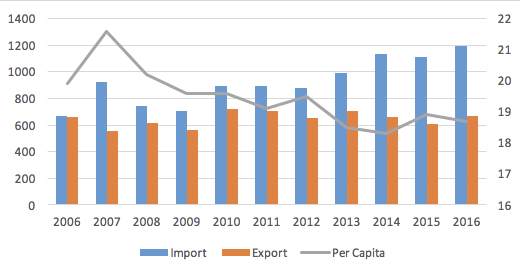
Figure 27. U.S. Fresh Onion Production and Prices, 2006-2016 (Million Pounds).
Source: Minor and Bonds (2017). Vegetables and Pulses Yearbook Data#89011/ April 06. ERS/USDA.
Nationwide, onion production has been steadily decreasing since its peak in 2007 where 7,098 million lb was produced. In 2015 there was a 5,728 million lb produced and in 2016 there was a slight increase to 6,228 million lb. On the other hand, onion prices have been fluctuating with the highest peak in 2015 at $17.60/cwt. The lowest price was recorded in 2011 at $10.90/cwt (Figure 27).
Prices for Vidalia onions have remained strong in Georgia compared to other types of onion and vegetables. From June to December, 2016 for instance, Vidalia onion prices varied from $15–$19 per 40-lb box whereas prices for Michigan yellow globe master container 16 3-lb mesh sack were $10-$12, repacked sizes were $7-$10 and 25-lb sack red globe jumbo onion was $8 (The Packer, 2016).
The new trend in onion production and marketing is organic. Currently, there are 6,192 organic operations in the United States with a total of 149,960 harvested acres. This translates to an average organic farm size of 24 acres (ERS/USDA, 2016). Due to the increasing interest in organic fresh produce, 15% of the total vegetables exported by the United States in 2015 comprised onions, carrots and cauliflowers. For instance, there was a 356% increase in organic onion exports from 2011-2015, which represents the greatest growth compared to all vegetables in the same time period (ERS/USDA, 2016). Currently Mexico is the largest market for exported U.S. organic onions as 99% are shipped there.
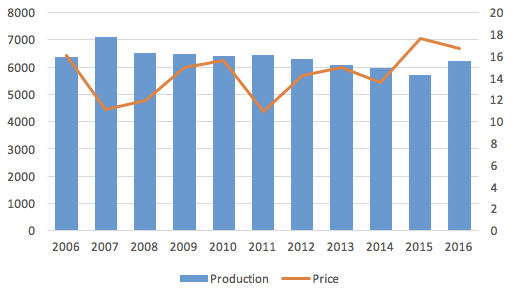
Figure 28. U.S. Fresh Onions Import and Export Trend and Per Capita Consumption: 2006-2016 (Million pounds).
Source: Minor and Bonds (2017). Vegetables and Pulses Yearbook Data#89011/ April 06. ERS/USDA.
Import-Export Trend and Per Capita Consumption
Despite the amount of onions produced in the United States (6,228 million in 2016), a significant quantity is still imported to supplement local supplies. The quantity of imported onions to the U.S. has been increasing steadily for the past decade. For instance, in 2006, 668.6 million lb were imported and that figure has grown to 1,190.6 million lb in 2016, being the peak. On the other hand, export growth has been decreasing. In other words, the U.S. onion industry has experienced a negative balance of trade of 5,033.4 million lb in 2016. This negative trend has been expanding for the past decade (Figure 28).
It is interesting to note that for the past decade the per capita consumption of onion has declined significantly. For instance, in 2012 per capita onion consumption was 19.5 lb compared to barely 16.7 lb in 2016.This means that Americans are producing less onions (Figure 27) and eating less onions (Figure 28). The highest per capita consumption was in 2007 when 21.6 lb were reported. About one-third of this is due to sweet onion consumption, with the Vidalia onion a significant, successful part. Onions along with other alliums have been touted in recent years for several health benefits, which have also contributed to increased consumption. China is the leading producer of onions in the world followed by India and the United States is ranked third (Table 16). Other important producing countries are Pakistan, Turkey, Iran, Egypt, Russia, Braziland Mexico. In 2015 China produced 20.9 million tonnes while India produced 8.2 million tonnes and the United States produced 3.3 million tonnes (Khan, 2015).
Table 16. Top 10 largest onion-producing countries in the world.

Onions are ranked number 1 among the top 10 vegetables produced in the state of Georgia. Georgia produces primarily short-day sweet Vidalia onions. In 2015, onions ranked 1st in terms of farm gate value generating $138 million equivalent to 13.6% of the total vegetable farm gate value of $1,02 billion (Table 17).
Table 17. Top 10 vegetables in Georgia (2015).

Source: 2014 Georgia Farm Gate Value Report (2015). Compiled and published annually by the Center for Agribusiness & Economic Development, Report Number: AR-15-01 (September)
Table 18. Top 10 onion-producing Georgia counties by value (2015)

Source: 2014 Georgia Farm Gate Value Report (2015). Compiled and published annually by the Center for Agribusiness & Economic Development, Report Number: AR-15-01 (September).
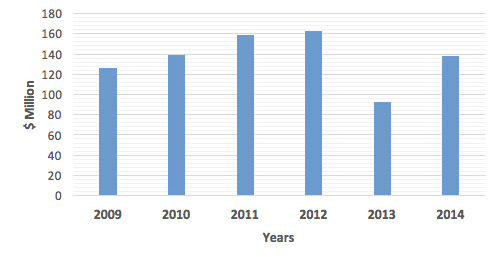
Figure 29. Georgia Farm Gate Value for Onion, 2009-2014.
Source: 2014 Georgia Farm Gate Value Report (2015). Compiled and published annually by the Center for Agribusiness & Economic Development, Report Number: AR-15-01 (September)
At the state level, Georgia’s farm gate value grew steadily from 2009 and peaked in 2012, then it started trending down. For instance, onions generated $126 million in 2009 and a record $163 million in 2012. The value decreased to $93 million in 2013 and increased to $138 million in 2014 (Figure 29).
Although vegetable production is predominantly in south Georgia, some counties do better than others. Table 18 shows the top 10 counties responsible for the majority of onion production in the state. In 2015, Tattnall County was ranked 1st generating $61 million in farm gate value while Evans county ranked 10th with $0.395 million.
CONCLUSION
Onions are an important commercial vegetable in the state of Georgia in terms of production acreages, yield and farm gate value respectively. As long as the growers continue to adhere to the recommendations from Extension Specialists and Researchers, this crop will continue to rank high in the top 10 vegetables produced in the state. Although the United States is ranked 3rd in the world for onion production, a significant quantity of onions is still imported to compliment domestic consumption. The U.S. imports more onions than it exports.
References
Center for Agribusiness & Economic Development. (2015). 2014 Georgia Farm Gate Value Report (Report No. AR-15-01). University of Georgia College of Agricultural and Environmental Sciences. https://caed.uga.edu/publications/farm-gate-value.html
Khan, I. (2015). Top 10 Largest Onion Producing Countries in the World. World Knowing. http://worldknowing.com/top-10-largest-onion-producing-country-in-the-world
The Packer. (2016). Commodity pricing. http://www.thepacker.com/vegetables/onions/commodity-pricing
Wells H. F., & Bentley, J. K. (2016, August 30). Vegetables and pulses outlook (Special Article No. VGS-357-SA1). U.S. Department of Agriculture Economic Research Service. https://www.ers.usda.gov/webdocs/outlooks/74639/60318_vgs-357-sa1_dga.pdf?v=881
Status and Revision History
Published on Jul 01, 2001
Unpublished/Removed on May 15, 2009
Published with Minor Revisions on Jun 21, 2017
